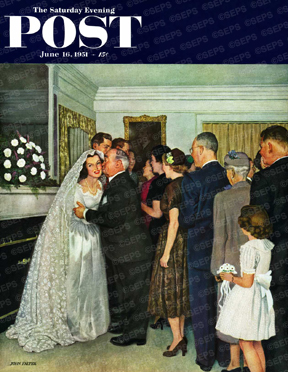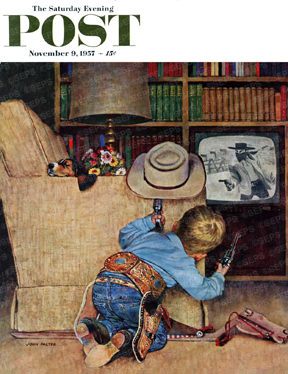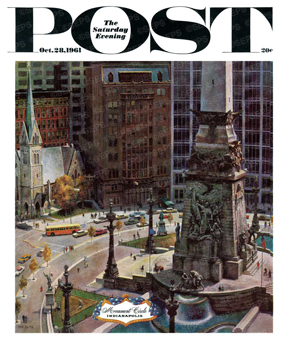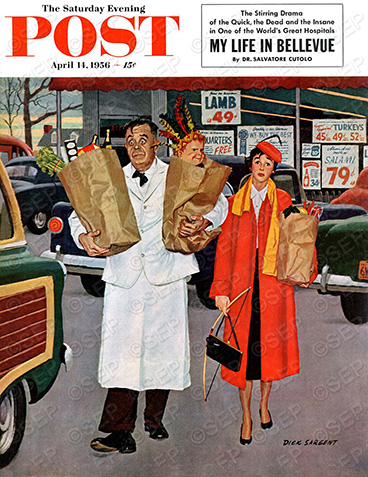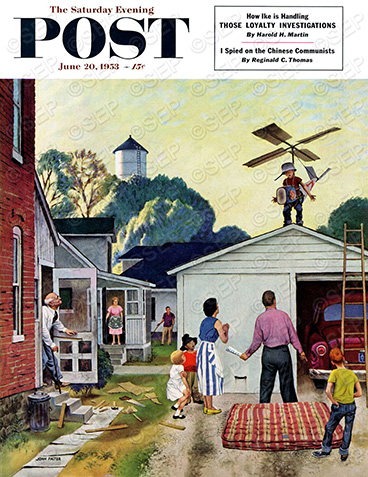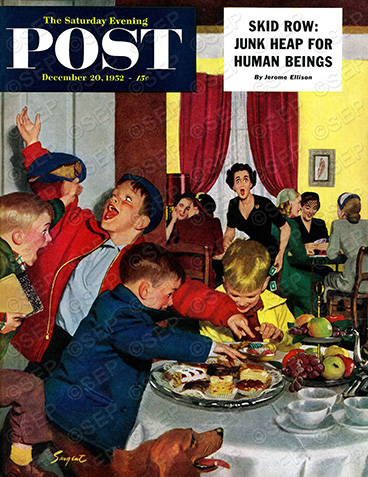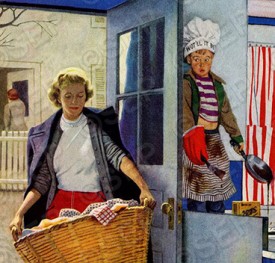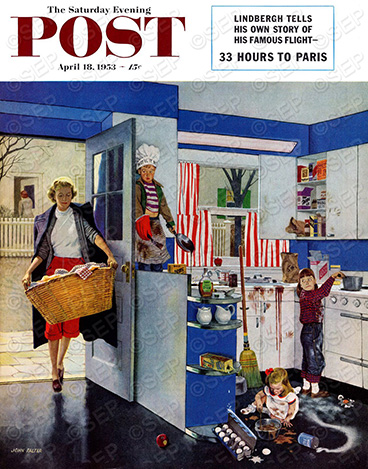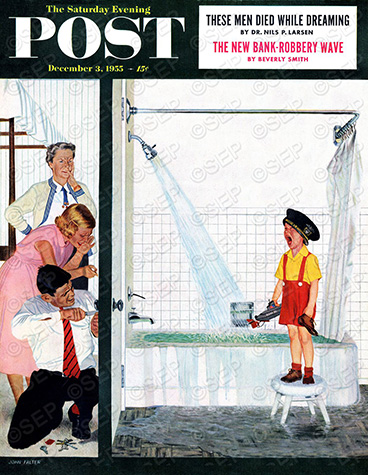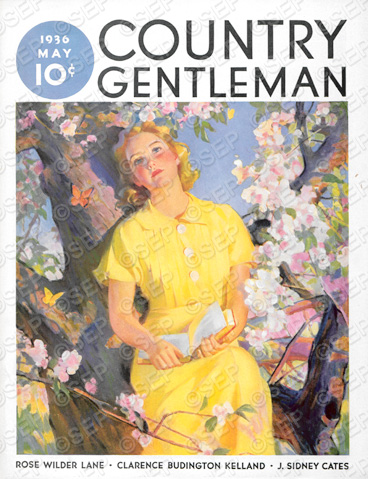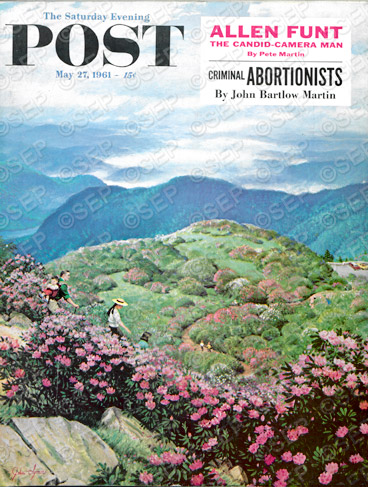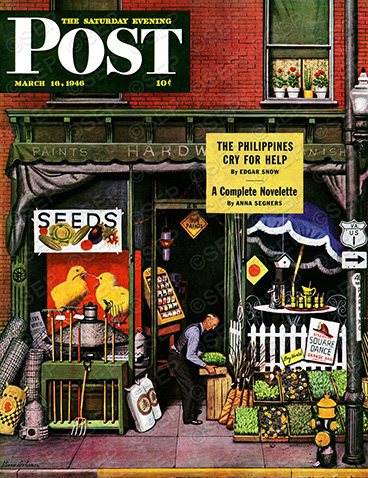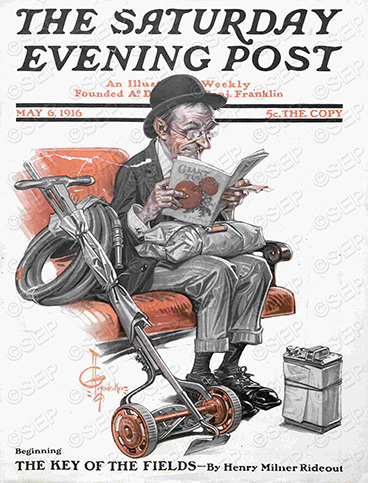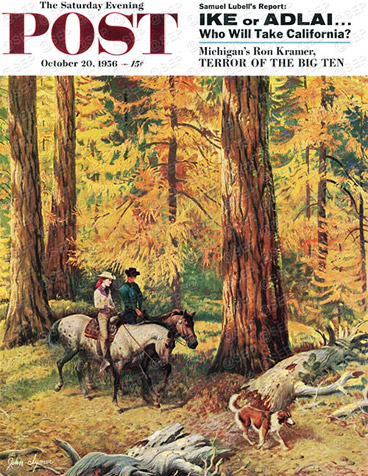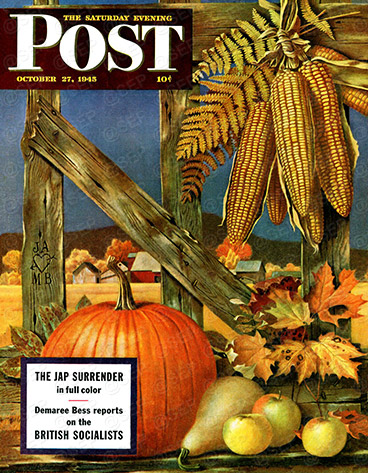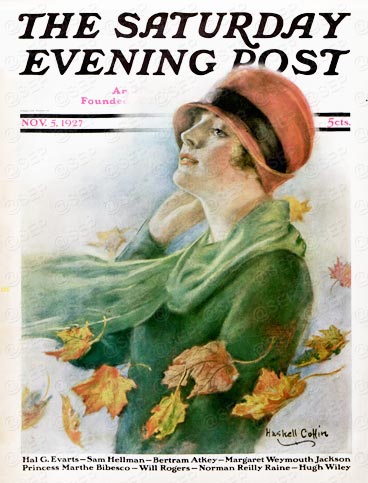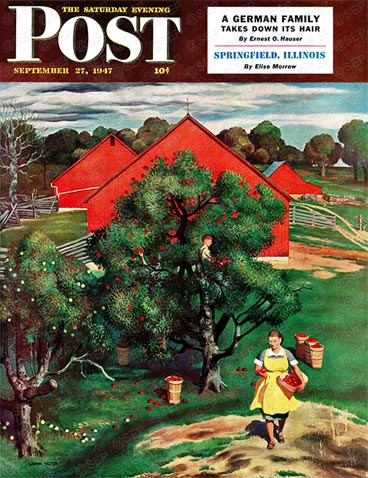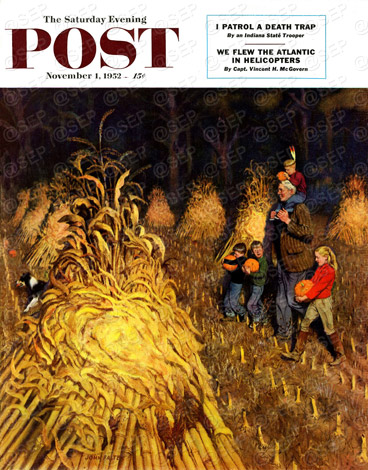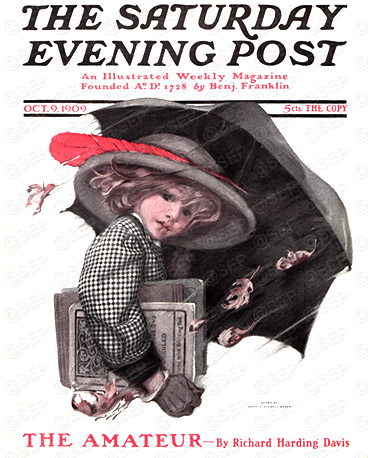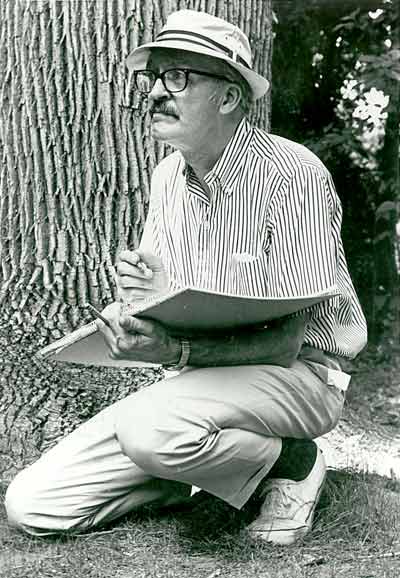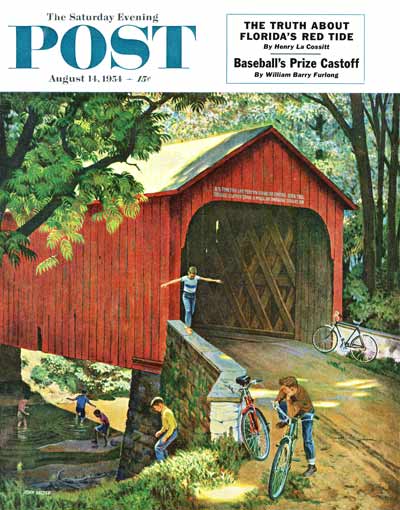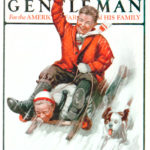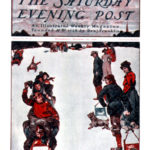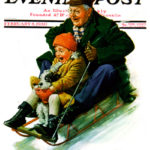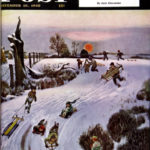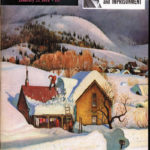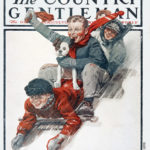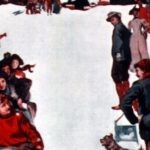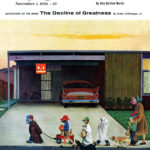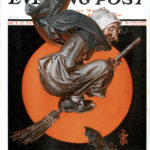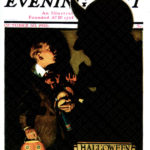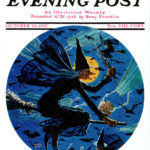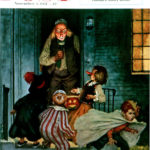Falling for Autumn
Plunging into leaf piles, playing after-school football, and harvesting pumpkins, these cover scenes embrace the joys of autumn.
Go long! After school lets out, the corner of Sixth Street transforms into a homegrown gridiron. Luckily, an overthrow is an easy feat for the receiver in plaid.
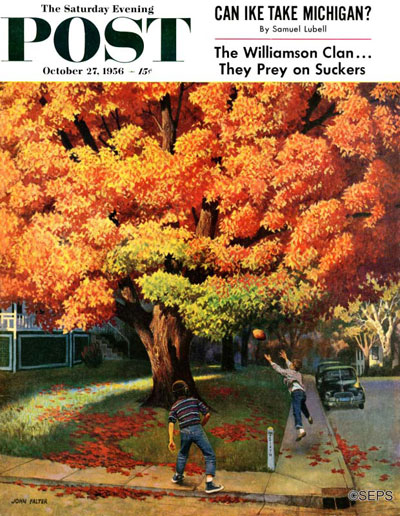
October 27, 1956
She rakes, he dives. Plunging into leaves is the epitome of fall—even the dog seems to agree.
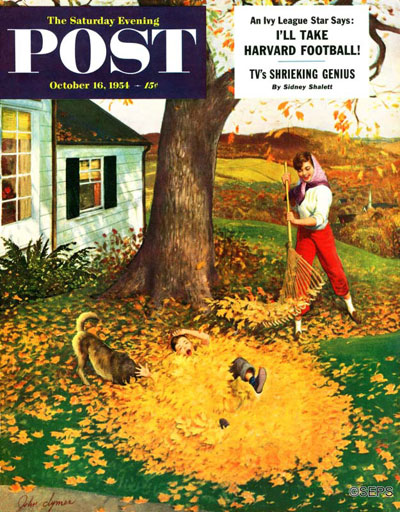
October 16, 1954
Successful day? These boys seem to think so, though Mom might not be impressed with their new pet.
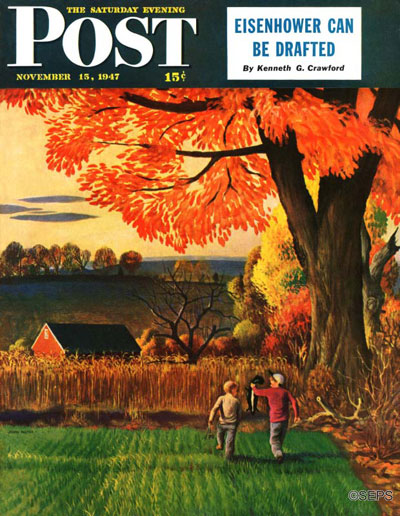
November 15, 1947
With crop season in full swing, the pressure’s on for scarecrows to keep those pesky birds at bay. This one, however, seems to have lost touch with its purpose.
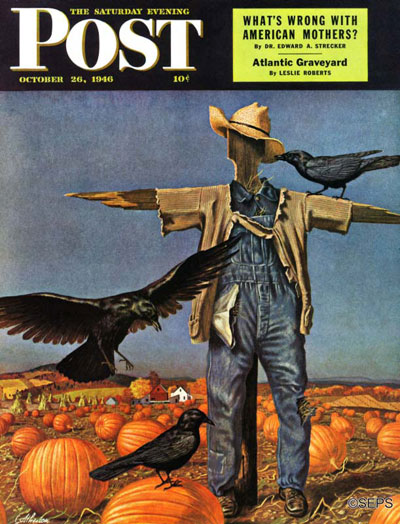
October 26, 1946
Nestling in plain sight might not be the best place for this tom to hide when Thanksgiving is around the corner. Here’s hoping the farmer and his son have other plans for that axe.
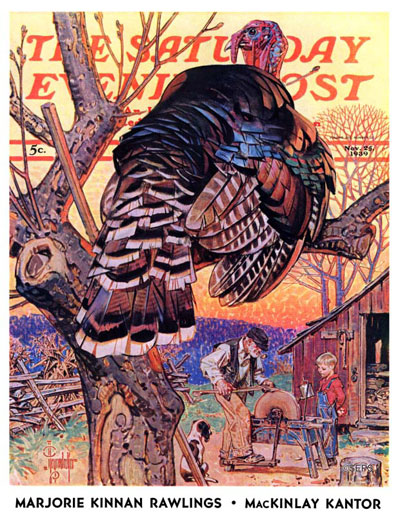
November 25, 1939
“Wait for me!” Best way to ruin a romantic autumn walk? Let your little brother tag along.
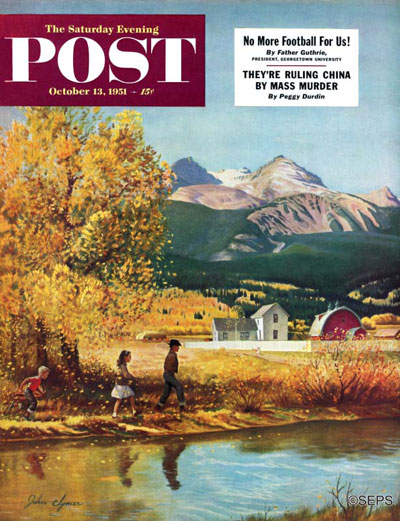
October 13, 1951
People live to gossip, especially when love is in the air. If you have even the tiniest bit of doubt over your new fall fling, we recommend not holding hands in public.
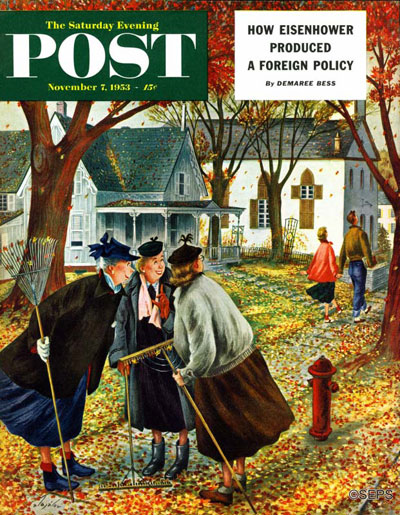
November 7, 1953
Fellas, take note. The odds of getting the girl greatly increase on an intimate horseback ride during the peak of fall. A dream date for sure …
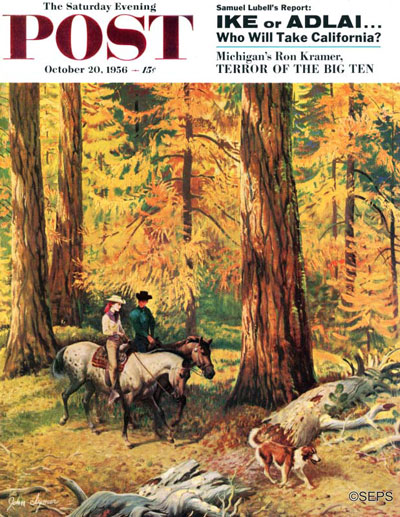
October 20, 1956
… unless she’s afraid of horses. Definitely come up with another plan if her knee-jerk reaction is to hide behind you.
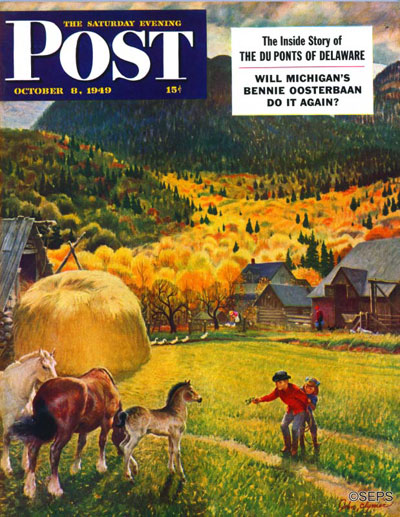
October 8, 1949
On the Green
Whether you tee off with millions watching or just practice putting into an orange juice tumbler, these golf covers consecrate the bond of anyone who’s ever taken aim at a hole in one.
It’s not the size of the trophy that counts, but what you do with it. And from the looks of this winner’s smirk, his silver trinket is going to be the gem of the mantelpiece.
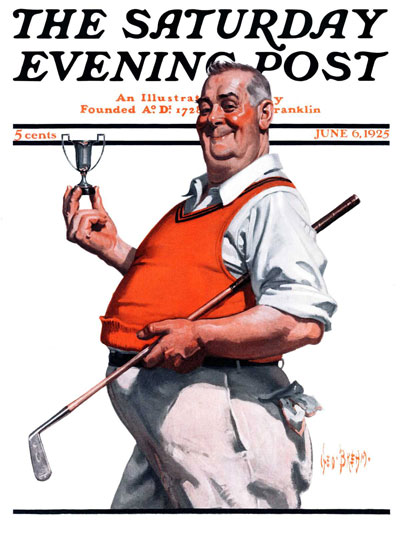
June 6, 1925
She may have to work on her precision. But after unearthing the fractured remains of her sandtrap shot, this golfer can feel confident in the power behind her drive.
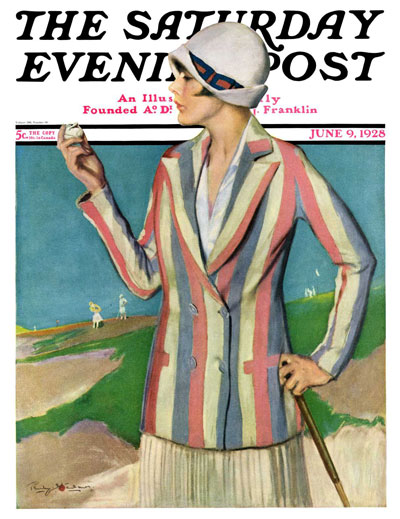
June 9, 1928
Five o’clock means five o’clock! Scrutinizing the ticking hands on his wrist probably isn’t going to deliver his opponents any quicker, but one can still hope.
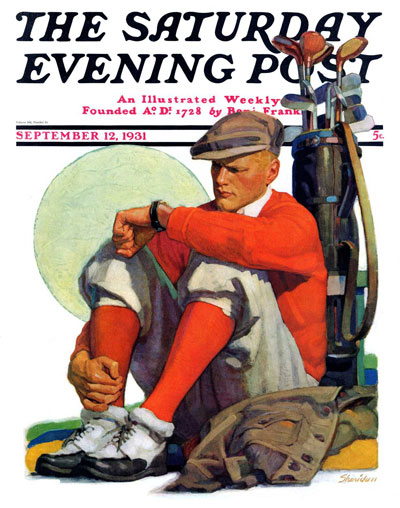
September 12, 1931
Becoming one with the green in more ways than one: With gloves on tight and chin held high, this Portrait of a Lady Golfer by Penrhyn Stanlaws inspires the very spirit of the pastime.
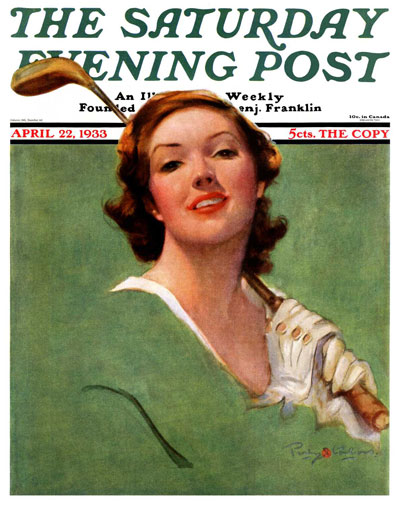
April 22, 1933
The moon may be out, but you wouldn’t know it from these players determined to improve their swing for tomorrow’s game. It doesn’t hurt that in the dark, no one can see your worst slice.
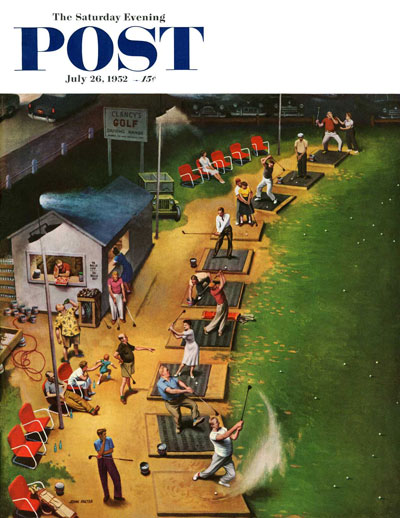
July 26, 1952
Evidently, even some artistically unsubtle smudge craft isn’t enough to get the chores done. All play and no work may keep Jack from getting dull, but it won’t keep his marriage intact.
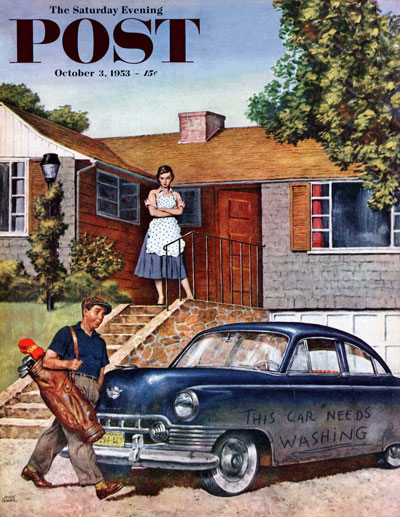
October 3, 1953
Just a blade of grass shy of victory: These weary players on the final hole can study the devastating tally all they want, but it won’t give that ball the nudge it needs.
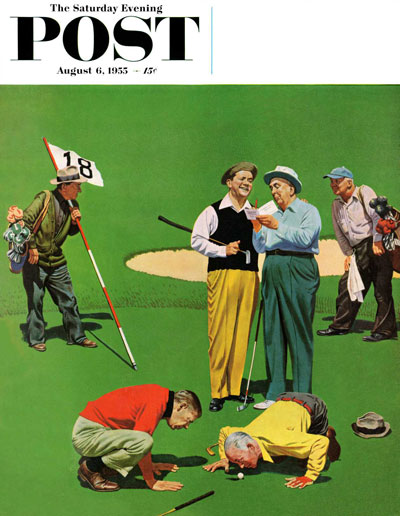
August 6, 1955
Anything worth doing is worth doing well, but the conga line of miffed putters waiting to play through might not take that mantra to heart.
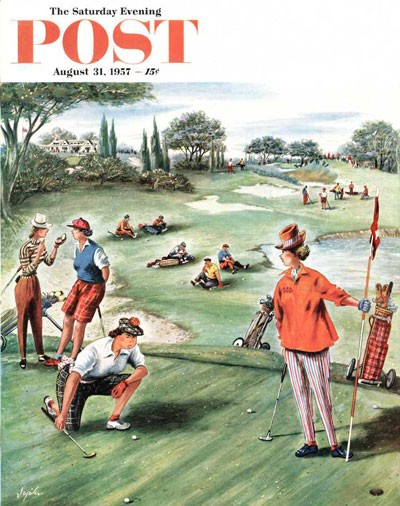
August 31, 1957
With a championship on the line and every fan’s eye glued to his stroke, this pro is none too pleased with the smoky flirtation going on behind him. If he can’t sink this, there may be cause to call fore over a club instead of a ball.
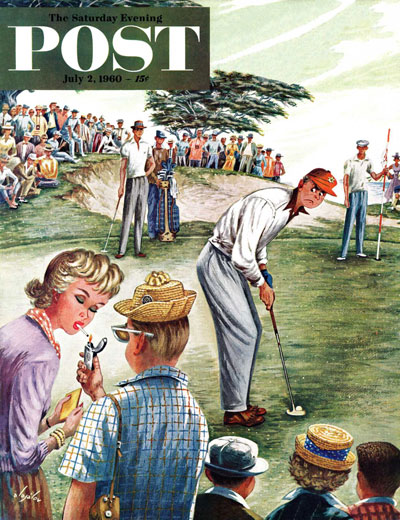
July 2, 1960
Everyone needs a hobby. And this 1960s housewife has discovered hers in those gleaming new clubs, even as her hubby looks on in goggle-eyed bewilderment.
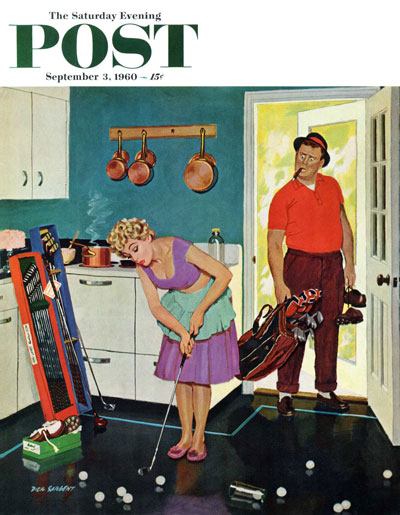
September 3, 1960
The Modern Vacation
Fun for the Whole Family!
The educational road trip leading up to a spectacular vista is not always appreciated by those for whom all that effort was expended. Artist Richard Sargent was also a father and the complex and often hilarious child-parent dynamic was a regular theme.
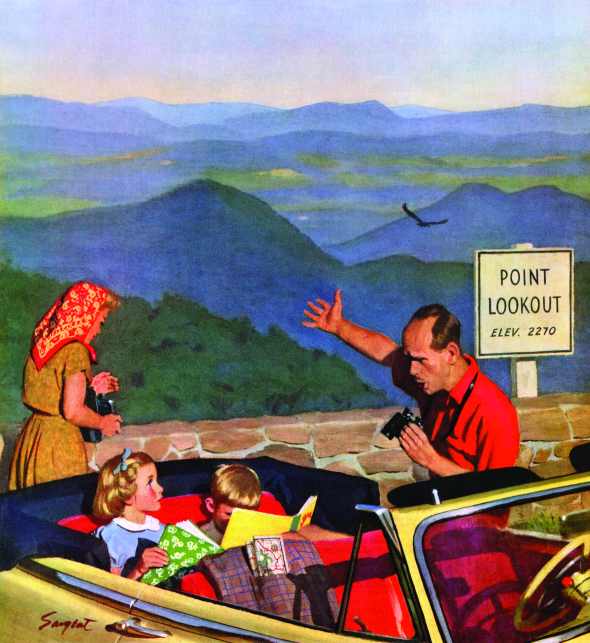
Richard Sargent
The Saturday Evening Post
July 18, 1953
Beached
Retirees in the 1930s may not have known how to dress down for the shore, but they seem to be enjoying the sand just as much as their modern-day equivalents do.
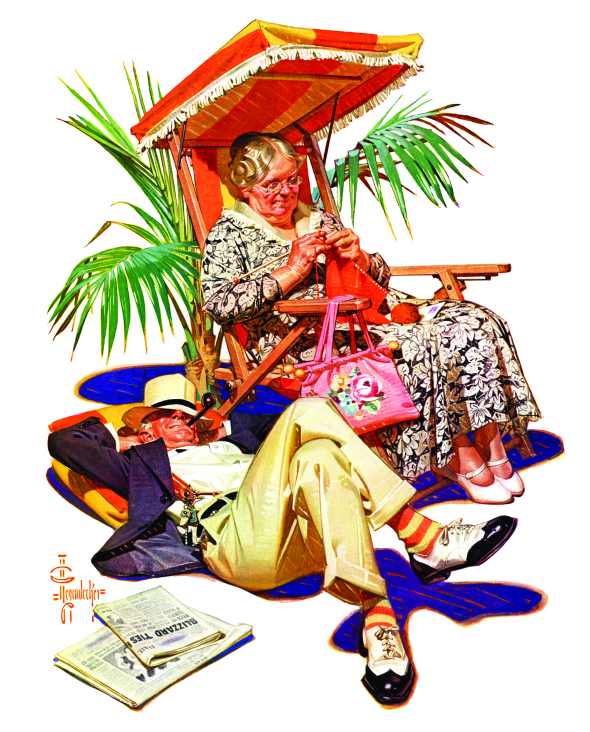
J.C. Leyendecker
The Saturday Evening Post
February 20, 1937
Dedicated vacationers march to the water first thing in the morning, forming an impromptu parade.
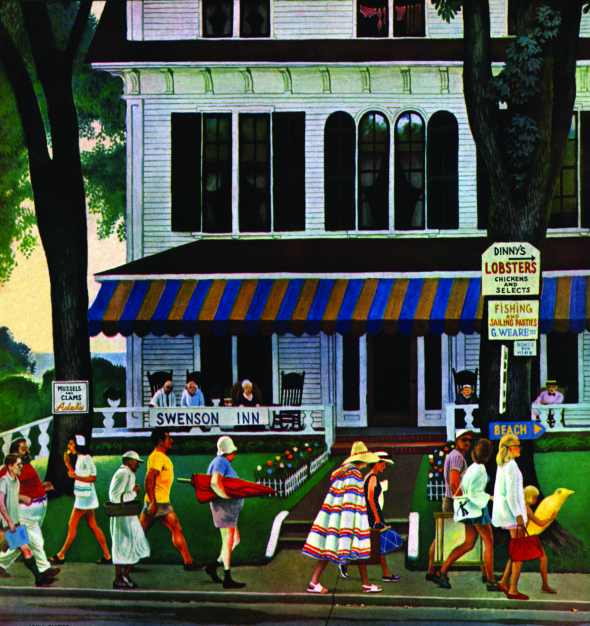
John Falter
The Saturday Evening Post
August 2, 1947
Baggage
Universal Truth No. 1: After a week at the beach, you will accumulate at least twice the baggage that you arrived with.
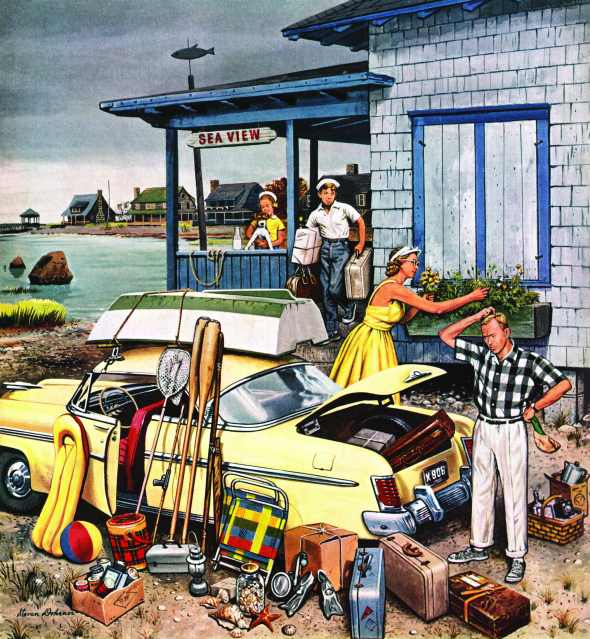
Stevan Dohanos
The Saturday Evening Post
September 8, 1956
Universal Truth No. 2: Vacations are short and much anticipated, which doesn’t leave time for unpacking — at least not in Dad’s view.
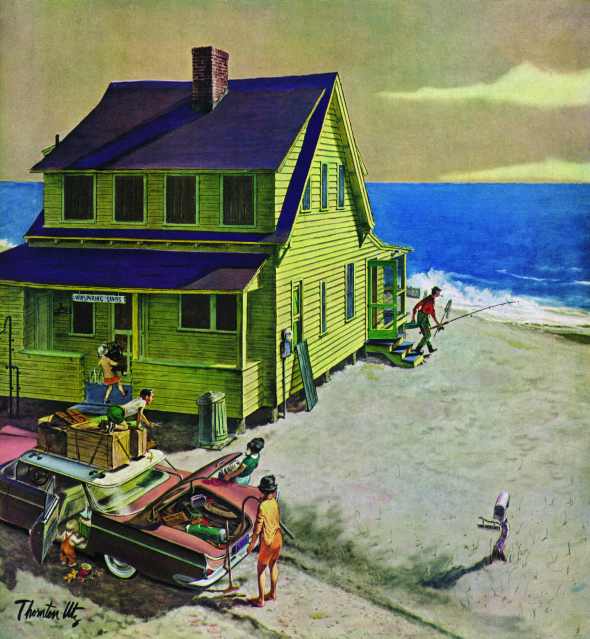
Thornton Utz
The Saturday Evening Post
June 18, 1960
Disappointment
When your job is to help others achieve their dreams as is the case for this travel agent, sometimes you need a quiet moment to dream one up for yourself.
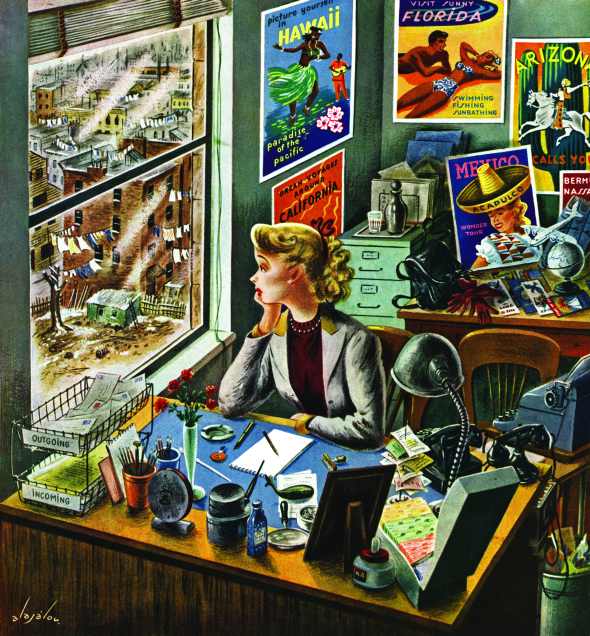
Constantin Alajalov
The Saturday Evening Post
February 12, 1949
You can’t plan the weather for that dream vacation, but this family is determined to get in as much outdoor time as humanly possible.
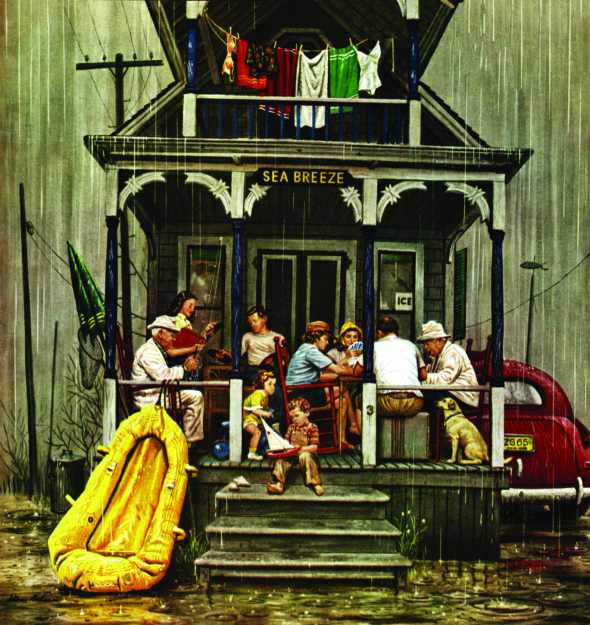
Stevan Dohanos
The Saturday Evening Post
July 31, 1948
Back Again
When you go away for what looks to be about three weeks — judging from the number of newspapers on the lawn, strewn about the front entry by some lout of a paperboy — there’s a lot of cleanup to be done. The weight of this realization is quite evident in the droop of Father’s shoulders.
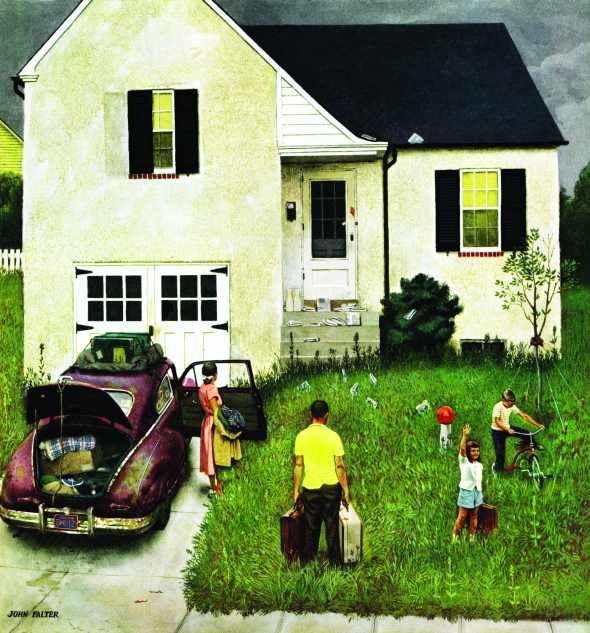
John Falter
The Saturday Evening Post
August 23, 1952
There may be no place like home, but after a long trip, Rockwell’s family requires rest.
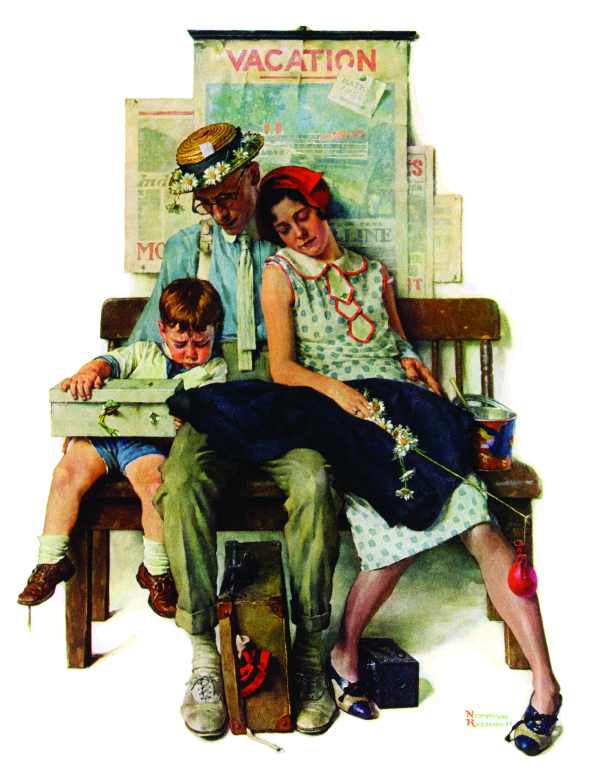
Norman Rockwell
The Saturday Evening Post
September 13, 1930
John Falter
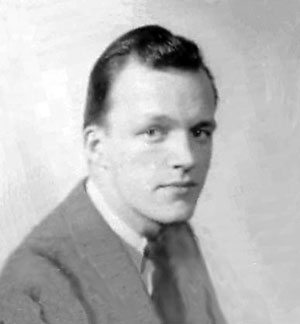
“As for a painting, it has to be a love affair every time. If you aren’t in love with what you are trying to put on your canvas, you better quit.” —John Falter
John Falter was a born and raised Midwestern illustrator, originally from Nebraska. Born in 1910 in Plattsmouth, Falter moved to Falls City in 1916 for his father’s job. From an early age, Falter found art and illustration attractive.
Even as a young man, the artist marketed his skills, creating a comic strip called “Down Thru the Ages” for the Falls City Journal. The Journal’s cartoonist, “Ding” Darling, happened to be a Pulitzer Prize-winning artist who encouraged Falter in his illustrative work.
Falter graduated high school in 1928, and chose to continue his artistic education at the Kansas City Art Institute. While studying in Kansas City, he eventually won a scholarship allowing him to continue his art education at the Art Students League in New York City at the height of the Great Depression.
Covers by John Falter
Receptions Line
John Falter
June 16, 1951
Good Guys Wear White Hats
John Falter
November 9, 1957
Monument Circle
John Falter
October 28, 1961
Work was initially scarce, however, the artist survived creating cover illustrations for “pulp” magazines. He, like so many other illustrators of his time, moved to the unofficially labeled “illustrator’s colony” in New Rochelle, NY.
Success arrived in a flurry once Falter opened his own illustration studio based out of New Rochelle, acquiring commissions from magazines and advertising firms in the city. He drew inspiration from his idol, Norman Rockwell, who lived nearby.
By 1932, at the age of 22, John Falter met and married Margaret Huggins of Emporia, Kansas. In 1956, John Falter’s first marriage ended in divorce. His illustration career stabilized and he eventually picked up consistent work from Liberty Magazine in 1933, completing three illustrations a week.
Falter picked up more advertising work, accumulating a stable of clients ranging from Gulf Oil and Four Roses Whiskey, to Arrow Shirts and Pall Mall Cigarettes. At the height of his illustration career, Falter was working for McCall’s, Life Magazine, Look, Good Housekeeping, and Cosmopolitan. The consistency of this advertising work allowed Falter the free time to experiment in his art, picking up other media such as easel painting in oils and watercolors.
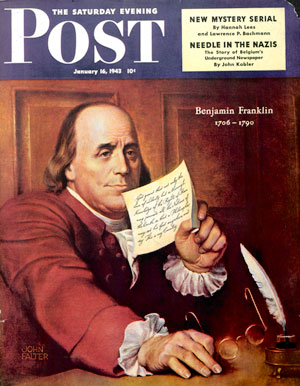
By John Falter
January 16, 1943
His first cover for The Saturday Evening Post was a portrait of Benjamin Franklin for the January 16, 1943 issue. One of The Post’s youngest contributors, Falter amassed a large portfolio of Post covers, completing 129 covers over the course of his life. His works, much like those of Norman Rockwell, are simple observations of every day American life which may have otherwise gone unnoticed if not picked apart by a skilled artist.
By the time America entered both of World War II’s wartime theaters in the Pacific and in Europe, Falter had enlisted in the Navy where he was put on special assignment to design recruitment posters specifically for women. Completing over 300 posters, Falter’s works are now famous for dealing with the “loose-lips-sink-ships” theme. He was even commissioned, while in the service, for illustrations depicting American Medal of Honor recipients on twelve covers of Esquire Magazine.
In 1956, his first marriage ended in divorce. In 1957 he married his second wife, Mary Elizabeth “Boo” LaRue Wiley. She brought three stepchildren from her first marriage into his life — Elizabeth “Lisa”, Sarah, and John “Jay.” In 1958, the couple had a daughter, Suzanne.
Though popular in the 1940s and 1950s, illustration fell into decline during the 1960s. John Falter was able to adapt and find an even more profitable line of work in portraiture and western art during the late 1970s and 1980s. He was inducted into the Illustrators Hall of Fame in 1976 and made a member of the National Academy of Western Art in 1978. In April of 1982, Falter suffered a stroke and died from complications within a month’s time. He left behind a wide artistic legacy ranging from cover art and advertising, to murals, portraiture, prints, and paintings in a wide variety of media and genres of art.
More on John Falter:
Museums: John Philip Falter Museum in Falls City, Nebraska
Birth: February 28, 1910
Education: Kansas City Art Institute, Art Students League of New York City, Grand Central School of Art
Family: Married Mary Elizabeth LaRue Wiley; stepchildren Elizabeth, Sarah, and John; daughter, Suzanne
Residences: Plattsmouth, Nebraska; Falls City, Nebraska; Kansas City, Missouri; New York City, New York; New Rochelle, New York; Philadelphia, Pennsylvania
Occupations: Artist, Illustrator, Portraitist, Painter, Book Cover illustrator, printer
Style/Genre: American Art, Western Art
Death: May 20, 1982
Spring Covers: A Perennial Favorite
The spring equinox occurred weeks ago, March 20 to be exact, which means this winter’s tale has (finally!) come to a welcome end.
Here at The Saturday Evening Post, we have historically welcomed each spring with delightful covers from some of our greatest artists and illustrators, each cover offering a different take on varied spring themes. The following three covers show the range of springtime weather, and the ways we take advantage (or don’t) of the change in season.
The most prevalent activity of spring is the tending of of gardens. In Thornton Utz’s, “Spring Yardwork” from May 18, 1957, the viewer sees an entire neighborhood planting, watering, mowing, mulching, raking, and so on and so forth down the straight line of synonymous 1950s homes.
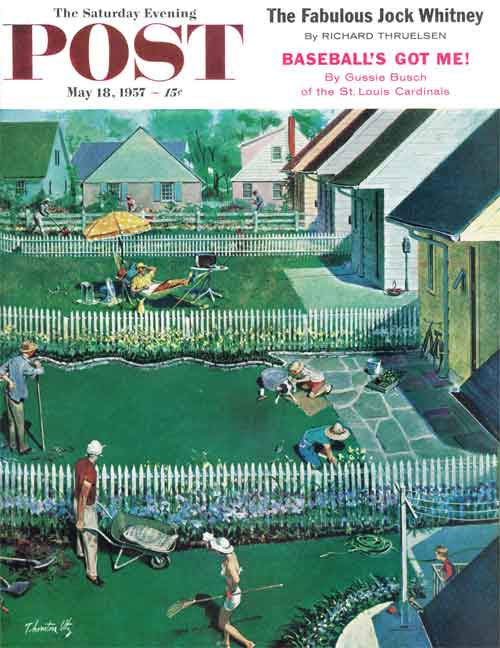
At the far end of the street, we view a man sunbathing in a yard completely lacking any cultivation. There are no perennials, no sprouting annual bulbs planted the previous fall, and he is not planting for the summer harvest. If anything, the old parable of the grasshopper and the ant comes to mind.
The lazy grasshopper homeowner at the far end looks out jealously from his lawn chair and barren yard to see the fruits of his ant neighbors’ labors. It’s not too late for him to make hay while the sun shines, but he looks awfully comfy drink in hand.
From sunshine to April showers, “Mailman” by Stevan Dohanos, which appeared on the May 13, 1944 issue, shows a devoted neighborhood staple, the rain-or-shine employees of the United Sates Postal Service completing his daily duties in a solemn, light afternoon shower. The mailman is an American ideal of civil service, the difficulty of his responsibilities unknown to those who conveniently find their mail waiting, as if by magic, in their mailboxes.
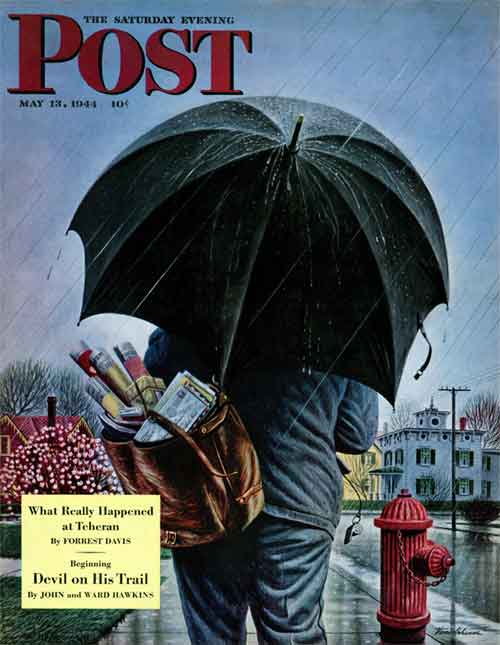
In contrast, “Spring Cleaning” by John Falter, from the March 26, 1949 cover, shows people who, unlike Dohanos’ mailman, have the luxury of finishing their chores on a beautiful, sunny day. Most would rather have fun on a sun-kissed afternoon, but completing a task in good weather is certainly preferable to the rain.
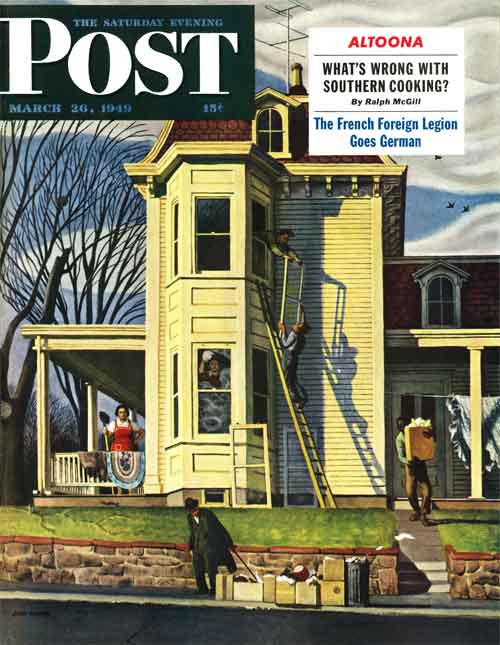
This season has much to offer, so take advantage! It’s time to head outside, to enjoy warmer weather, to plant our gardens, and to take charge of our spring-cleaning procrastinations (or eh, maybe next year). This season of early awakenings only comes once a year, so make sure to take a moment and appreciate this singular spring season.
Beyond the Canvas: Imagination survives despite the influence of television
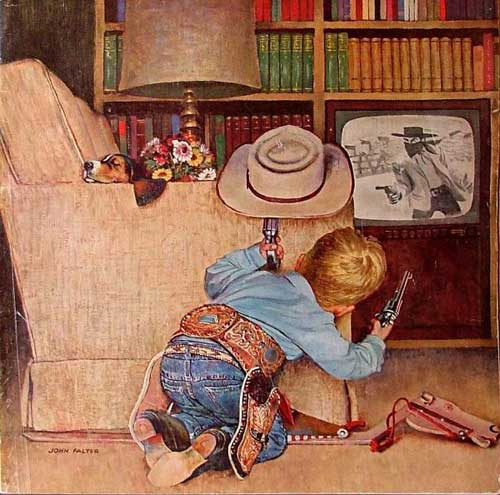
A young imagination has the power to make a 1950s living room into the Wild West, turning a playful child into a ruthless gunslinger.
Artist and illustrator John Falter once said he tried “to put down on canvas a piece of America, a stage set, a framework for the imagination to travel around in.”
Falter takes a subtle moment to comment on the abilities of a child’s mind for his November 9, 1957 cover of The Saturday Evening Post with the illustration “Good Guys Wear White Hats.”
I once inherited my baby-boomer father’s cap gun and broomstick-horse from my grandmother. Apparently, my father used to believe he was The Lone Ranger’s trusted ally. The now 60-year-old family heirloom of western wars won and lost in front of the television screen passes down the family line of childhood cowboys. I have since given the faux-weapons to a niece, furthering the generational creativity.
In this 1950s image, a time when parents first began to worry about the lethargic effects of television on young minds, we see creativity at work. The little boy interacts playfully with the television housed among bookshelves whose tales and stories older generations valued for creative fictions. The television is the boy’s interactive source of afternoon entertainment.
Could the work’s title hold a deeper observation about the purity and innocence of childhood? The title evokes a common assertion: the one who wears white is a good guy. Except in this illustration, our boy is not wearing his white hat. The little man uses one of his two pistols to hold up the white hat as a decoy while he prepares to trick his on-screen enemy. Is the boy still a “good guy” even though he does not wear the hat?
The answer may be in the color pallet elsewhere in the illustration. The little boy hides behind a beige couch, and he’s kneeling on a khaki colored carpet. His hair is blond and his skin is white. On the opposite end of the frame, the bandit exists inside the dark brown television set surrounded by books. The black-and-white screen further accentuates the bandit’s dark attire. In the end, we know who the bad guy really is.
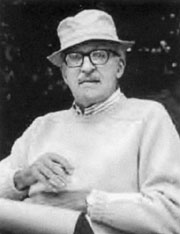 To learn more about John Falter and to see other inside illustrations and covers from this artist, click here!.
To learn more about John Falter and to see other inside illustrations and covers from this artist, click here!.Classic Covers: 1950s Moms
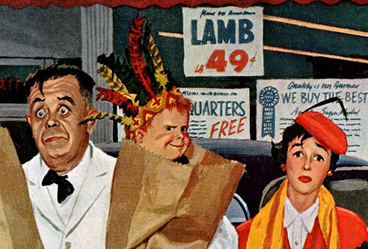
Celebrate Mother’s Day with 1950s covers from popular Post illustrators Richard “Dick” Sargent (1911-1978) and John Falter (1910-1982). And if any of these covers remind you of your own childhood … you might want to order a bigger bouquet.
Sack Full of Trouble
Richard Sargent
April 14, 1956
Moms today may not have to reenact the American Indian Wars with junior in the store aisles, but that doesn’t mean multitasking with a grocery list and an active toddler is any easier than it was 50 years ago.
Popular artist Dick Sargent was a master of what art experts have come to call “sitcom covers.” Editors noted of this 1956 cover that Sargent, just to prove it could be done, borrowed a little boy to fit into a paper bag. “He let the boy’s father do it to assure that he himself would not get scalped.”
Sargent’s adeptness with facial expressions told the story: the mom’s weariness, the shell-shocked look of the grocer, and an expression on the boy’s face that says, “My work is done here.”
Learning to Fly
John Falter
June 20, 1953
“Once upon a time a very small boy stood on the roof of the garage behind his home,” Post editors wrote of 1953’s Learning to Fly (at right). “He had made every reasonable arrangement to fly down. He had carefully studied the aerodynamics of the situation and met them with the most scientific equipment available.”
The cover was a flashback to a Nebraska afternoon when artist John Falter himself was on the roof of his boyhood home, as his own mother agonized below. And the boy, who grew up to recreate the comical events of his childhood for the enjoyment of Post readers everywhere, eventually found his wings.
Crashing Mom’s Card Party
Richard Sargent
December 20, 1952
“What is lovelier than the glow of carefree joy in the faces of happy children?” asked Post editors of this 1952 illustration. “Will the lady on the cover have the heart to defend her food and change those expressions to the pinched melancholy of starvation? She will if she can make it across the room in time.”
Sargent had set the scene for Crashing Mom’s Card Party in his dining room with real pastries, testing the self-restraint of his three sons. “The mouths of those sons began to water,” wrote the editors, “They watered for a week. Two weeks. Three. Then the sons were released at the pastry. They ate it so fast they apparently did not notice it was petrified, claims the fiendish father.”
Mother’s Little Helpers
John Falter
April 18, 1953
There is much to be said about good intentions, besides the road to you-know-where being paved with them. Adding to the tension in this piece, an apple waits in the unsuspecting Mom’s path (no doubt left by one of her good-intentioned little helpers).
“My main concern in doing Post covers was trying to do something based on my own experiences,” illustrator John Falter said. “I found my niche as a painter of Americana with an accent on the Middle West. I brought out some of the homeliness and humor of Middle Western town life and home life.”
Overflowing Tub
John Falter
December 3, 1955
Like Learning to Fly, this Falter cover is fraught with enough anxiety to make the viewer cringe for Mom (and Dad). While the artist conveys enough despair for us to recognize that the situation is distressing, the overall effect is humorous.
In addition to childhood’s predicaments, Falter depicted a wide range of subjects, including nature’s beauty and intricate bird’s eye views of cities.
Visit our Artists Gallery and tell us which is your favorite Post cover by John Falter, Richard Sargent, or other artists. For a chance to be featured in our next Readers’ Favorites series, send your email to [email protected]. Remember to include your name, along with the title and date (or just a good description) of your favorite piece.
Classic Covers: A Hint of Spring
We are over it! We’re through with snow and slush, and we’re seeking hints of spring from our finest cover artists: Rockwell, Leyendecker, Dohanos, Falter, Clymer, and more.
Shoveling Floral Shop Sidewalk
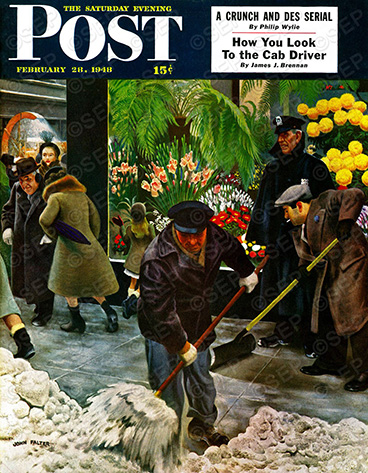
Shoveling Floral Shop Sidewalk
John Falter
February 28, 1948
“It was cold in New York,” Post editors say of this John Falter (1910-1982) cover, “and the cagey artist did most of his investigating behind glass, riding up and down on a Madison Avenue bus.” Painting the scene, Falter figured the frozen-faced workers would get an ironic chuckle from the fact that inside the flower shop window it is spring. Or perhaps not. Editors also had to note that Falter delivered his picture to the Post “just before the first of the winter’s oversize snowstorms hit New York. Then the artist hauled out for Arizona, where you may enjoy scenes like this in comfort.”
Springtime, 1935 Boy with Bunny
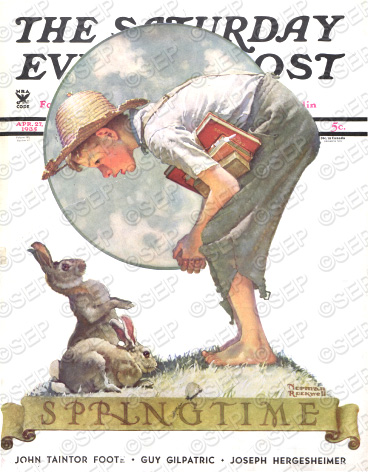
Springtime, 1935 Boy with Bunny
Norman Rockwell
April 27, 1935
“You can’t buy a straw hat and make it look old by rubbing dirt in it,” Norman Rockwell (1894-1978) wrote in My Adventures as an Illustrator. “A hat has to be worn in the sun and sweated in and sat on and rained on. Then it’ll be old. And look it.” In 1935 Rockwell was asked to illustrate Mark Twain’s The Adventures of Tom Sawyer and The Adventures of Huckleberry Finn, and he took the costuming very seriously. Desperately needing the right hat for Huck, he found just the thing in, appropriately, Hannibal, Missouri, Twain’s hometown. He spotted “a man walking along the road wearing a straw hat in a beautiful state of decay” and managed to buy it from him. Before long he ended up with a carload of clothes, “all old and rotten, battered, tattered, and splotched.”
Folks around Hannibal no doubt talked for a long time about that crazy guy who paid good money for their old duds, but the book illustrations were done to everyone’s satisfaction. And, like the boy greeting spring (left) with his worn hat and raggedy pants, some Post covers reflected the “Huck Finn look.”
Reading Among the Blossoms
F. Sands Brunner
Country Gentleman
May 1, 1936
Despite the fact that F. Sands Brunner (1886-1954) was very much a rugged outdoorsman who enjoyed camping, canoeing, and mountain climbing, most of his paintings reflect domesticity with adorable children and lovely women. This 1936 work from Post sister publication Country Gentleman is a case in point. The rich color and skillful use of lighting are typical of Brunner’s work. The Boyertown, Pennsylvania, native painted three Country Gentleman and two Post covers.
Appalachian Rhododendrons
John Clymer
May 27, 1961
Nature took over on a grand scale in most of John Clymer’s (1907-1989) 80 Post covers, and people were secondary. In fact, the viewer almost has to squint to see the family consisting of Dad with baby on his back, Mom in straw hat, and daughter leading them along the trail to Craggy Pinnacle near Asheville, North Carolina. Clymer told Post editors, “Sections of the trail wind through 10-foot-high rhododendrons, and the ground is carpeted with the rich pink petals of the flowers that have fallen.”
“These floriferous slopes look their best in mid-June,” editors noted in 1961, “as they did when the Catawba and the Cherokee held sway in the Carolinas. But if the scenery of the area has not changed much, the people have. What self-respecting Indian brave would have toted a papoose on his back?”
Hardware Store at Springtime
Stevan Dohanos
March 16, 1946
Artist Stevan Dohanos (1907-1994) loved hardware stores, and editors informed us that “the store he has painted affectionately for this week’s cover is a composite of many where Dohanos himself has obeyed the impulse, very strong in the spring, to buy a lot of new garden tools.” They warned, however, “this equipment buying is by all odds the most popular phase of gardening, for on a bland spring day there is nothing like the feel of a good rake or hoe in your hand—in the hardware store.”
Ready to Garden
J.C. Leyendecker
May 6, 1916
This gentleman has made his trip to the hardware store and is hauling those spring purchases, lawn mower and all, back by public transportation. Perhaps more surprising is that the illustration is by the great J.C. Leyendecker, the man responsible for those chiseled Arrow Collar men who “haunted several generations of less fortunate-mankind,” according to David Rowland in a 1973 issue of the Post. In Leyendecker’s 40-plus years with The Saturday Evening Post, he showed amazing versatility as an illustrator, depicting subjects varying from elegant to comical in more than 300 covers.
Classic Covers: Autumn’s Beauty
“Autumn … the year’s last, loveliest smile,” wrote American poet William Cullen Bryant (1794-1878). Post cover artists illustrate why we love this time of year.
Fall Horseback Ride
Fall Horseback Ride
John Clymer
October 20, 1956
Most of the 80-plus Post covers by John Clymer feature natural settings: a shimmering lake surrounded by summer greenery, a charming New England harbor enveloped by snow, and, of course, views like the one at left of Washington, the beautiful state from which the artist hailed.
The riders are passing through a forest of tamaracks, which possess a rare trait among conifers; the needles turn gold in the autumn and fall to the forest floor. The fallen needles reflect the light, giving the ground an almost luminescent quality.
“In fall, every tamarack forest byway becomes a yellow brick road down which you can skip in a haze of glowing splendor,” writes Lori Micken in an online column for Montana Outdoors. The tamarack is a common sight in Clymer’s home state, and in this Post cover he captured just such a yellow brick road in Wilson Canyon, Washington.
Fall Harvest
Fall Harvest
John Atherton
October 27, 1945
The corn hanging on a neighbor’s barn in Arlington, Vermont, inspired John Atherton to begin sketching the harvest still life (left). “Knowing any harvest picture would need a pumpkin, he went into the garden and got one,” wrote Post editors in 1945. Deciding autumn leaves were needed, the artist gathered some along the road. Ferns would also add to the arrangement, so out he went to gather a few. The ferns died very quickly, and he gathered more. “By the time he had set his stage, Mr. Atherton had done quite a little of harvesting himself,” wrote the editors.
Between 1942 and 1961 Atherton painted 47 Post covers. His style was realism, known for its accurate, almost photographic portrayal of its subjects. This was a far cry from the idealized images depicted by his friend, Norman Rockwell. Atherton’s critical attitude to such sentimentality is noted in the feature, “Till the Cows Come Home.” But the painter was not completely immune to sentiment: Note the initials carved in the beam at left, presumably signifying the love between him and his wife Maxine Breeze.
Fall Leaves
Fall Leaves
W. Haskell Coffin
November 5, 1927
“The making of a portrait is an imaginative work, because of the blending of two personalities, the sitter and the artist,” William Haskell Coffin (1878-1941) told Charleston, South Carolina, reporters upon returning to his hometown.
Coffin studied portraiture while at the Corcoran School of Art in Washington, D.C., and in Europe. But the formative years of his artistic career were spent in New York, where he won critical acclaim painting portraits of the chorus girls from Ziegfeld’s Follies—some of whom modeled for his 32 Post covers.
The attractive young women were often posed with a single object, such as a book or floral bouquet. In this 1927 illustration, the props are merely a few autumn leaves, some gray clouds, and the chill autumn breeze.
Apple Picking Time
Apple Picking Time
John Falter
September 27, 1947
“It has to be a love affair every time,” artist John Falter said about his work. “If you aren’t in love with what you are trying to put on canvas, you’d better quit.”
Falter started the painting at left by sketching the barns and rail fence at a farm near Weston, Missouri, and then completed it at his home in Pennsylvania. The trees, the apple pickers, and the farm woman were done from memory. As Post editors noted in 1947: “It wasn’t hard to recall similar scenes from his own boyhood (in Nebraska), although as he worked, the phase of apple picking Falter recalled most vividly was fresh apple pie.”
One of the Post’s most popular illustrators, Falter did more than 125 covers frequently employing a bird’s eye view of the scene. (See “Can You Guess the City?”)
Bring Home Pumpkins
Bring Home Pumpkins
John Falter
November 1, 1952
“Falter’s masterful treatment of light stems from the fact that he is a nature lover, and happily gifted to reflect her moods,” wrote the Post in 1971. “Most of his paintings interrelate human and natural life, and Falter seems ever drawn to the sky.”
The sky in this 1952 cover is nearly black, allowing the artist to contrast the golden haystacks with light from an unknown source, be that parking lot lights or lanterns. The blues, greens, and reds from the family heading back with their trophies add a needed dash of color.
Girl Walking to School
Girl Walking to School
Sarah Stilwell-Weber
October 9, 1909
In the heart of the Golden Age of Illustration, Sarah Stilwell-Weber (1878-1939) trained under the best: Howard Pyle. He and fellow students, such as Post illustrator N.C. Wyeth, greatly influenced her work.
A prolific artist, she illustrated over 65 Post covers between 1904 and 1925. During this period, she also worked for many other leading magazines, including Vogue, Collier’s, and Better Homes and Gardens.
Classic Covers: At Home in the ’50s
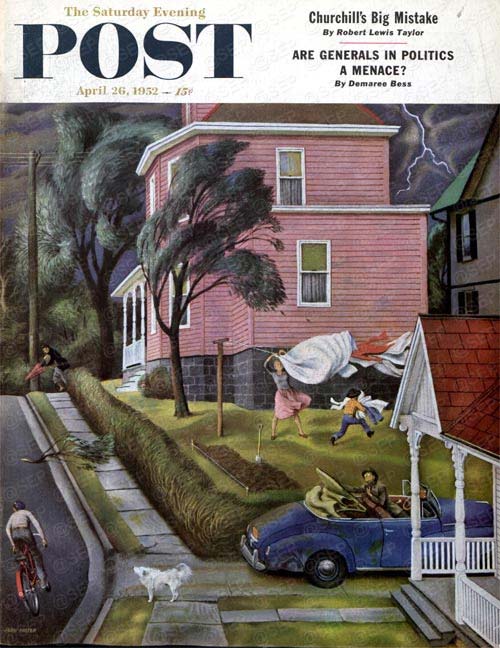
by John Falter
April 26, 1952
In a contemporary description of this cover, Post editors wrote that artist John Falter remembered well the spring storms from his Midwestern childhood in Nebraska and the way trees turned up the undersides of their leaves and looked like phantoms.
His more than 125 Post covers depicted everyday life, and often its foibles. (See “John Falter’s August.”)
Falter was known for his masterful use of outdoor light, reflected here with quickly disappearing patches of light and just as rapidly darkening skies.
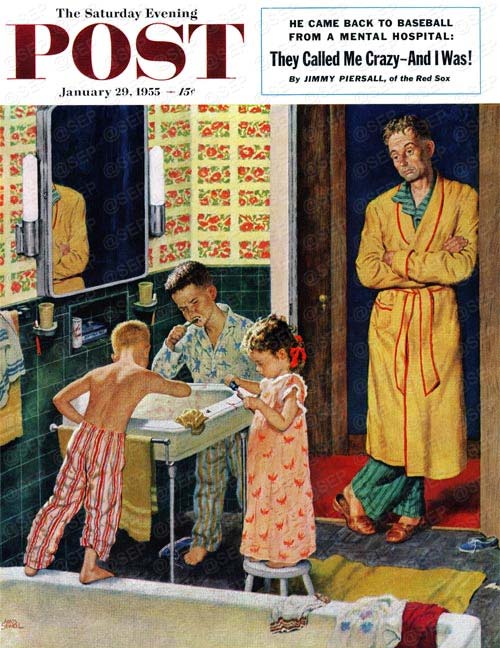
by Amos Sewell
January 29, 1955
According to a 1938 article in the Post, San Francisco-born artist Amos Sewell worked at a bank for several years, studying art in the evenings and spending vacations sketching up and down the Pacific coast. Then “in 1931, right in the middle of the depression, (Sewell) decided he was tired of the banking business and shipped out as a work-a-way on a lumber boat bound for New York, via the Panama Canal.”
In spite of his earlier vagabond lifestyle, many of Sewell’s 45 covers are notable for their homespun quality. Prime examples include this 1955 suburban toothbrushing scene, a father assembling a swing set (see “Thanks, Dad!”), and a little boy playing cowboy (see “Romance of the Cowboy”).
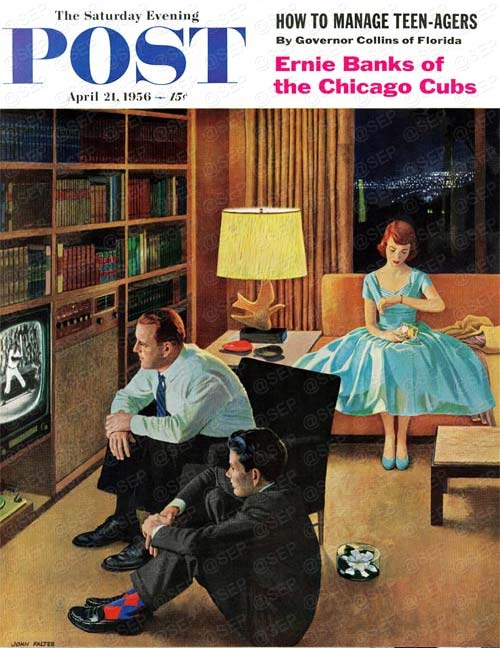
by John Falter
April 21, 1956
It all says mid-1950s: the TV, the dress, the lamp, the ashtrays… we have everything but tailfins here in this portrait of teenage angst.
The urbane setting (note the glittering city lights in the window) seems far removed from John Falter’s corn-fed Nebraskan boyhood. But let us be reminded of the artist’s meticulously rendered cityscapes as featured in “Can You Guess the City?”.
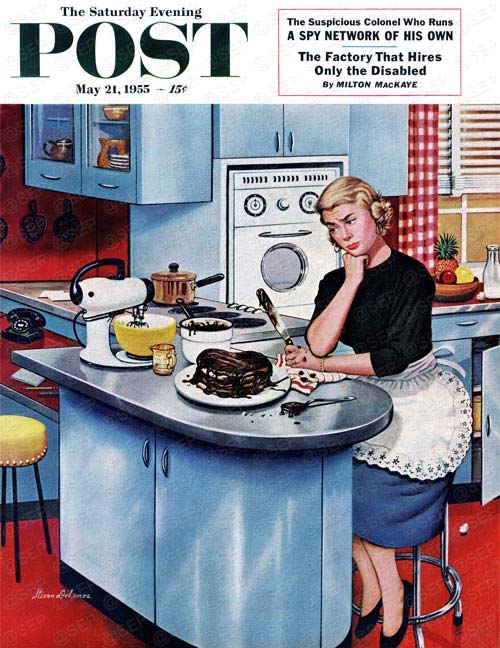
by Stevan Dohanos
May 21, 1955
Adept at drawing humor from everyday life, Stevan Dohanos’ covers include a toddler in a bedroom happily emptying purses as grown-ups gather in the next room and a woman “on vacation” at a beach cabin. (See “The Great Covers of Stevan Dohanos.”)
About this 1955 kitchen scene, Post editors wrote: “These newfangled kitchens certainly have helpful equipment, such as wall ovens with windows so one can watch a cake fall.”
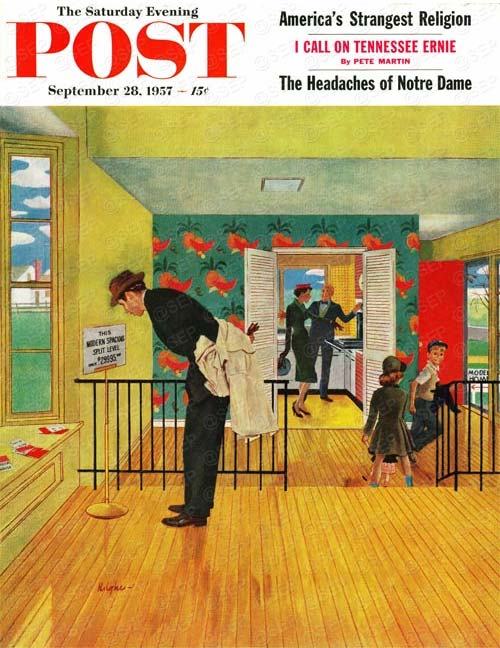
by George Hughes
September 28, 1957
Artist George Hughes favored vibrant colors and upper-middle class settings. Because the family is fashionably attired, we might assume some level of affluence. Even so, the average home was around $18,000 in 1950, and the sign in this model home states: “This modern spacious split level: $29,995.00.” No question that the family breadwinner is feeling a degree of sticker shock.
On the inside cover of this issue, Post editors quipped that Hughes himself had just purchased a new, one-level home in Vermont “because he is too old a man to climb steps.” Hughes would have been in his 50s at this time, but this sort of teasing banter was typical of the artist/editor relationship.
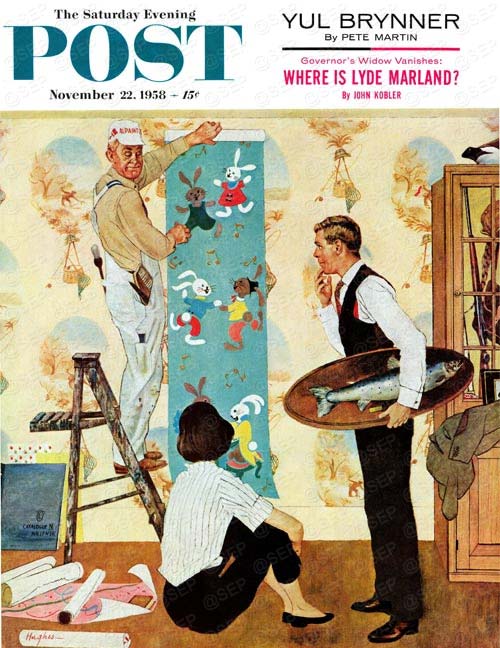
by George Hughes
November 22, 1958
Post editors wrote that the wallpaper with whitewater fishing scenes in Dad’s den is going, and he would soon be a “displaced person.” As the father of two young girls, illustrator George Hughes could certainly identify with turning man caves into kid’s rooms.
Renovation may have also been on his mind because the artist had recently moved from New York City to Arlington, Vermont, in part, to be near other Post artists like Norman Rockwell and Mead Schaeffer.
The country air must have suited Hughes, as the ’50s saw 80 George Hughes covers, making him the most prolific Post artist of the decade. By comparison, other prominent cover illustrators like Richard Sargent and John Falter did 35 and 60 covers, respectively (Rockwell did 45).
Reprints are available at Art.com.
Classic Covers: John Falter’s August
Post cover artist John Falter
“Nothing ever quenches the artist in him. … The world is his studio,” wrote The Saturday Evening Post in 1971 when artist John Falter came to visit.
While the Post‘s art director was preparing a portfolio of Falter paintings for that profile, intent over his drawing board, “he turned to find John scrunched down behind him, pencil in hand, sketching swiftly and surely.”
"Covered Bridge"
from August 14, 1954
Unlike the art of Rockwell, Leyendecker and most Post artists, John Falter’s work was less about people and more about settings. It was all about perspective, and the paintings seemed to be from the viewpoint of a bird in a nearby tree.
The lettering on the bridge warned: “$5 Fine for Any Person Riding or Driving Over this Bridge Faster Than a Walk or Smoking Segars On.”
Hey, the artist didn’t write it, he just painted it.
Post editors speculated that maybe Falter should be fined $5 for letting that kid walk on the wall. We’ll not fine him this time, since we love how he captured this 1954 Pennsylvania scene, which makes the viewer long to be a kid on a lazy summer day, riding his bike and wading in the creek.
“Home From Vacation”
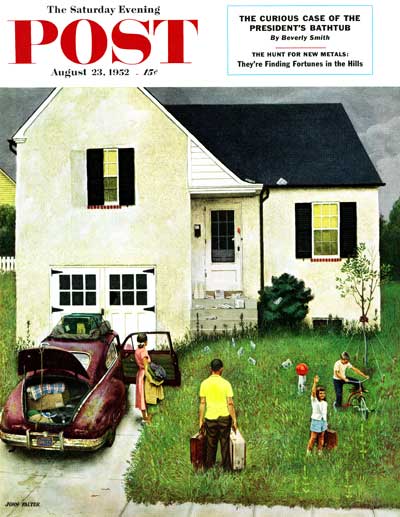
"Home From Vacation "
from August 23, 1952
Our bird is looking down at a family returning from vacation in August 1952—and perhaps wishing they hadn’t. Not only is the lawn in desperate need of attention, but that little bird forgot to tell them to cancel the newspapers and milk (oh dear, how old is that milk?). While dragging out the mower, mister, you might want to get the ladder—it appears a couple of newspapers landed on the roof. But, be it ever so neglected, there’s no place like home.
An interesting tidbit from the Post article noted above was that Falter always painted from the south, so we are looking north. In this instance, the ominous northern sky greets the weary travelers with the news that they probably need not get the mower out just yet. One can only hope the house key isn’t at the bottom of a suitcase.
“Country Auction”
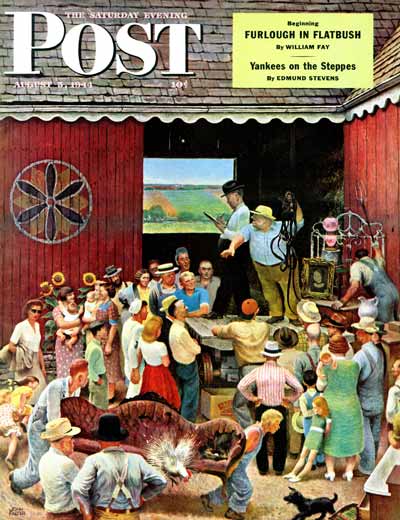
"Country Auction "
from August 5, 1944
It looks like everything from farm implements to household goods are going in this country auction, including the neglected Victorian loveseat in the foreground, much to the dismay of the offended hen who was using it for nesting. This cheerful cover was surely a treat in 1944, when war news was everywhere, including inside this issue.
Born in 1910, Falter succeeded at a young age. He was landing prestigious assignments at magazines like McCall’s, Cosmopolitan and Life when he interrupted his career to enter the Navy during World War II. Promoted from boatswain to lieutenant, he designed over 300 posters and other materials for the Navy recruitment program.
It is interesting to compare these bucolic covers with Falter’s cityscapes, again from the bird’s eye view, which were covered in “Can You Guess the City?”
“Eighteenth Hole”
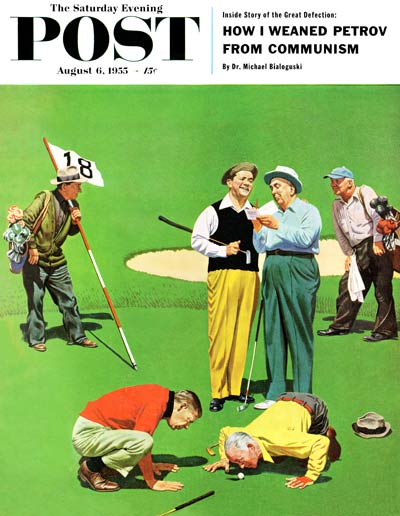
"Eighteenth Hole "
from August 6, 1955
It is estimated that John Falter completed over 5,000 paintings. This is not all that surprising, said a 1991 Post article, considering that “Falter awoke every morning at 3 o’clock to concentrate on the work in progress, and that he painted until 5:30 p.m. six days a week.”
It is doubtful he had much time for such pastimes as golf. As much as he enjoyed the outdoors, clearly his passion was art. “It has to be a love affair every time,” Falter said. “If you aren’t in love with what you are trying to put on that canvas, you better quit”.
“Evening Picnic”
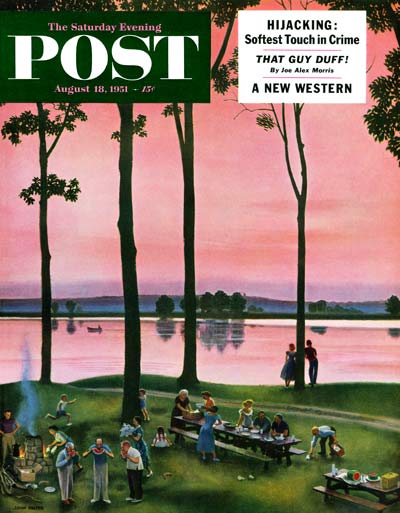
"Evening Picnic "
from August 18, 1951
“Sometimes Nature rains on a picnic; sometimes she is just neutral; and sometimes, as in this mood caught by John Falter’s brush, she glories in the occasion herself, painting a magic sunset, smoothing the waterways into mirrors, tempering the temperature, even arranging for the watermelons to be at their most luscious ripeness.” Post editors in 1951 waxed poetic over this cover of an evening picnic.
The 1971 Post profile echoed, “Falter’s masterful treatment of light stems from the fact that he is a nature lover and happily gifted to reflect her moods.”
Nature continued to be a focus after his Post years (the magazine covers went from illustrations to photos in the 1960s). A 1991 Post article noted that one of his projects was “190 canvases of scenes depicting the western migration from the Missouri River to the Rocky Mountains.”
That love of nature lasted until his death in 1982, noted the article. “His ashes were cast into the mouth of the Platte River where they would flow down the Missouri—the setting of many of his historical paintings.”
Remembering Artist John Falter
“I know that Norman Rockwell, who captures Americana so beautifully, is every American’s favorite artist; mine, however, is John Falter,” writes Ted Wallace. “Mr. Falter lived next door to my family in Atchison, Kansas, where from his attic studio he painted Midwestern scenes.”
There is a reason this particular 1946 Post cover is Mr. Wallace’s favorite; he is in the painting. “I am the little brother tagging along behind my big brother and his friends, just wanting to belong. Mr. Falter had seen the group of neighborhood boys from his studio window and incorporated us into the painting.”
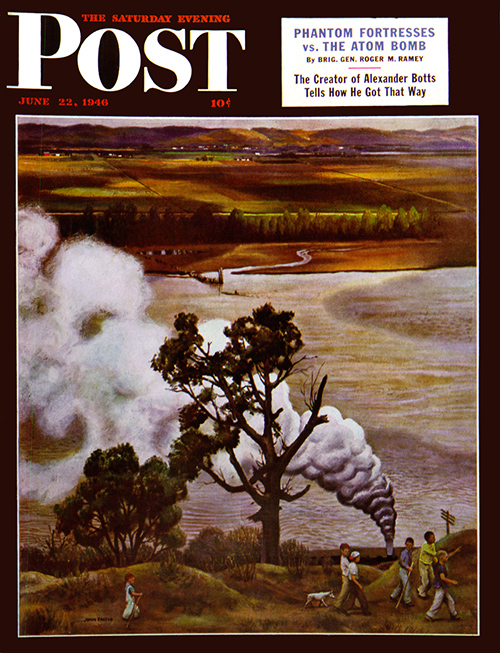
John Falter
June 22, 1946
What Falter was painting was one of the great rivers of America, the mighty Missouri. The viewer is in Kansas, looking across into Missouri. The boys are taking the same route as Lewis and Clark.
I have to say, Mr. Wallace puts it more eloquently: “…a summer scene overlooking the Missouri River and the fertile river bottoms beyond, with a group of rag-tag boys on a quest—searching for fun during the later years of World War II.”
“Time moves on and memories fade,” Wallace notes, “I only remember the names of four of the group—my brother, Bob Wallace (with the stick), and his friends, Jimmy Knight and Jimmy Morehead. The other two have faded into just memories. Of course, our dog Shorty is there with me…bringing up the rear.” Actually, for 65 years ago, that’s pretty darn good!
A steam locomotive always sticks in the minds of little boys. “We were always aware of the locomotives going up and down the tracks. Who could ever forget that mournful sound of the steam whistle fading off into the distance?” He also recalls, “the riverboats pushing barges up and down the river.”
“Those bluffs were our magic carpet as we chased the spirits of Lewis and Clark. Yes, we knew of their route and knew that we had walked in their foot steps. Our imaginations also ran rampant with the knowledge that Jesse James’ gang, Quantril’s raiders, and the Pony Express riders (just a few miles north) also traversed through that area; an area where time and young boys never stood still and life was simpler.”

“Mr. Falter gave my parents a copy of that issue of the magazine, which our mother kept for years until the Missouri claimed all of our memories when the Mighty Mo flooded those fertile river bottoms before my parents could save anything.”
“My brother and I now have a framed copy of that cover, obtained from the Post, that we and our families will treasure forever. Even after 65 years, the scene John Falter captured has not changed all that much; the steam engines are nothing but a memory, but the lives and dreams of those six boys will live on through generations to come.”
Classic Covers: Can You Guess the City?
We admit these beautiful cities look different now than they did in 1946 or 1960, but these covers by artist John Falter are still a treat. How many can you guess?
Fifth Avenue
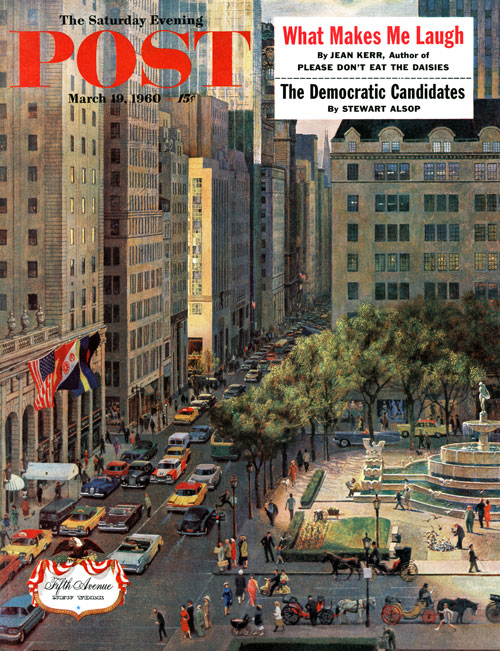
John Falter
March 19, 1960
This is one of the most famous streets in America, circa 1960. Next hint: the April sun in shining on the windows of Tiffany’s. Joggers, cars, horse and buggies, feeding the pigeons – so much detail that it was actually a fold-out cover. You can study it further or read on for the answer, as if you didn’t know: New York’s Fifth Avenue. By the way, you can click on any cover for a close-up.
Falls City, Nebraska at Christmas
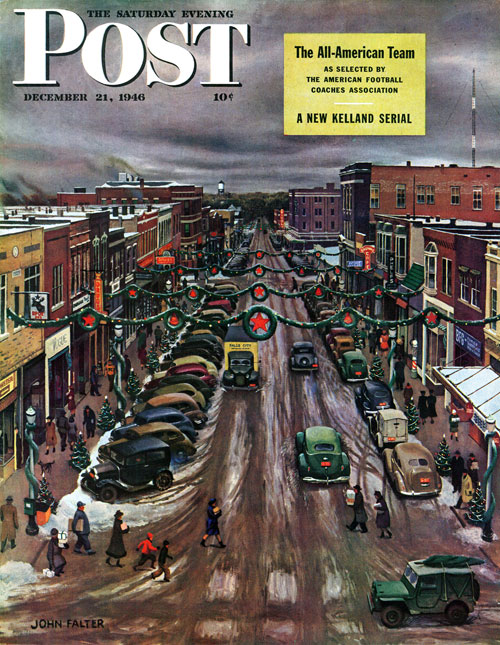
John Falter
December 21, 1946
A few weeks ago, Ruth Nixon wrote to us asking for John Falter covers. This one is of Falter’s (and Ruth’s) hometown of Falls City, Nebraska, Christmas time 1946. The future Post cover artist worked on this very street in his father’s clothing store. He had the exalted title of “pants runner”; he ran trousers from the store to the tailor’s to get them shortened. You have to love the cars in this one. Thanks so much, Ruth, for giving us the idea for this segment!
Monument Circle
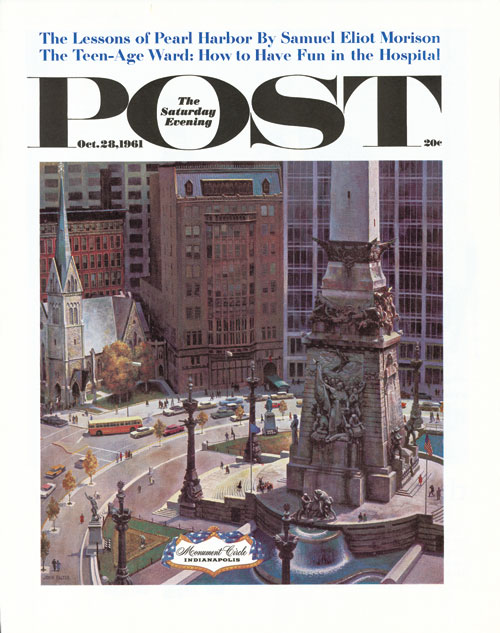
John Falter
October 28, 1961
I knew this one instantly! I’d like to think it’s because I’m so darned smart, but actually it’s because I’ve worked in downtown Indianapolis and have had lunch out on Monument Circle on many fine days. Dedicated in 1902, the Soldiers and Sailors Monument is at the very heart of downtown. Again, the minute artist’s detail: A teeny-tiny group of school children are viewing the beautiful statues of soldiers and sailors – which, unfortunately, you have to be quite close to see how exquisite they are. The beautiful English Gothic Christ Church still stands, I’m happy to say, as does the neighboring Columbia Club building. Indy thanks you for this one, Mr. Falter.
Kansas City
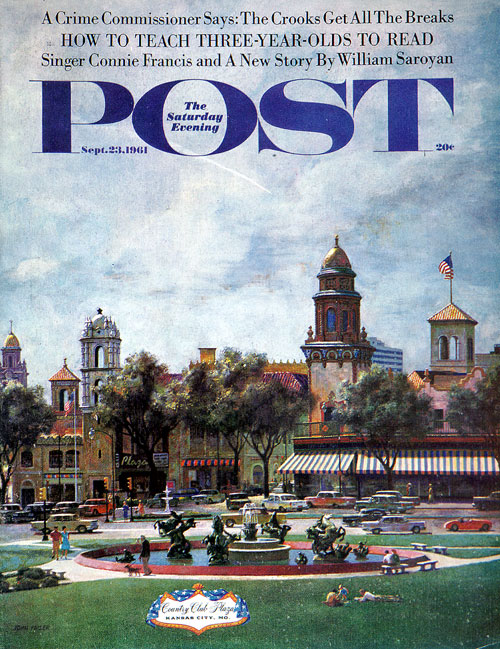
John Falter
September 23, 1961
If this cover is any indication, this is one of the prettiest cities around. “Spanish architecture in Missouri?” the editors asked. “If such a state of affairs seems peculiar, consider that the unpredictable Show Me state even has a town named Peculiar, some twenty miles south of here.” “Here” is lovely Kansas City in 1961. The charming community of shops pictured here was conceived and built by Jesse Clyde Nichols (1880-1950) to whom the fountain in the foreground is a memorial.
Peachtree Street
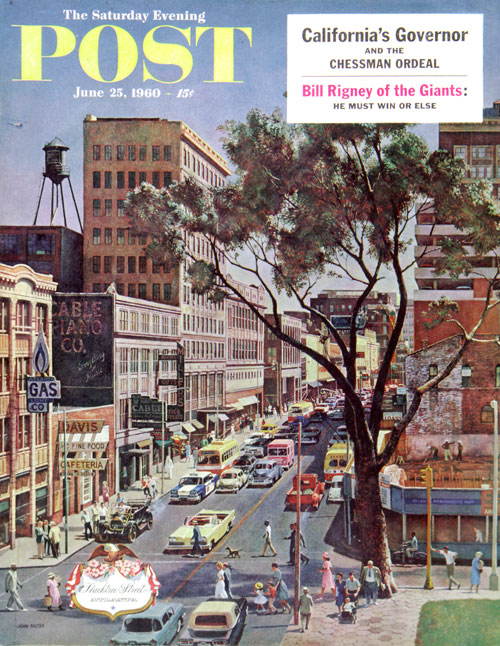
John Falter
June 25, 1960
Let’s head south and see what people are doing on this fine June day in 1960. Construction workers are constructing (right of that big tree), pedestrians are pedestrianing, and traffic is flowing well on Peachtree Street in Atlanta. Get out the magnifying glass again, because the editors identified one of the teeny-tiny people to the far lower left: “ the gentleman on crutches is Ernest Rogers, Atlanta Journal columnist and the popular ‘Mayor of Peachtree Street’”. More editorial info: “In the early nineteenth century this was a sinuous ridgetop trail leading to an Indian settlement known as The Standing Peachtree; today it’s the main artery in the economic capitol of the South. That towering tree in the foreground is an American elm. Our scene contains no peach trees—they don’t thrive in downtown Atlanta.”
Michigan Avenue, Chicago
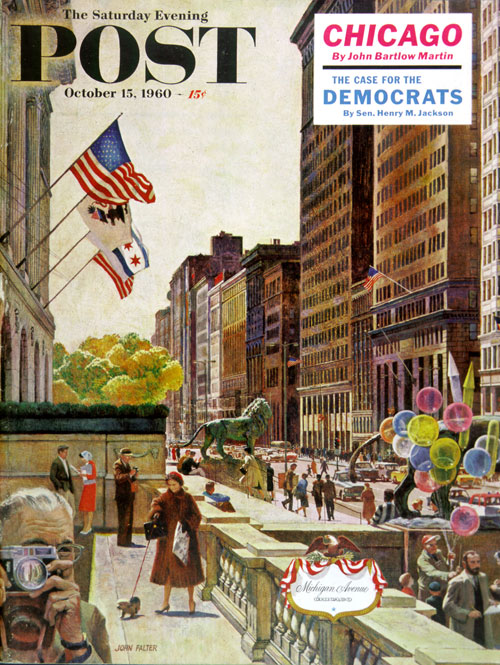
John Falter
October 15, 1960
We must not forget the Windy City. Again, there was so much wonderful stuff to show, this was a fold-out cover, but we can show you half. This is Michigan Avenue, looking north toward the Tribune Tower and the Wrigley Building. Where, you ask? Again, the incredible detail: “The Wrigley Building and environs are reflected in the camera lens at left”. You can tell it’s a crisp autumn day from the coats being worn and the changing leaves on the tree to the left. Another identifiable pedestrian: “The whiskered gent with the sketch pad is the late Louis Sullivan, Frank Lloyd Wright’s mentor and an architect who helped reshape the face of this frisky city.”
Town Square, New Castle, Delaware
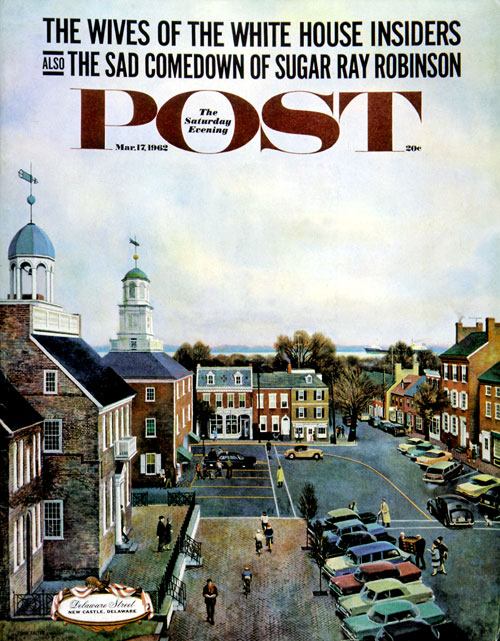
John Falter
March 17, 1962
I must add one more because this is such a charming cover. New Castle, Delaware was not a big city (pop. 4469 at the time of this 1962 cover), but it won over artist Falter. The editors shared some interesting history: “Founded in 1651, it was William Penn’s landing place when he came to America at in 1682. Penn is thought to have spent a night in the house at the extreme right of our cover. The spire atop the Court House (left foreground) was used as the center of a twelve-mile radius in part of the 1763-67 survey—to settle a boundary dispute—that resulted in the Mason-Dixon Line.” You thought the Mason-Dixon line was way down South, didn’t you? Nope. Personally, I’m interested in the people at the lower right of the cover trying to fit a lovely antique into a car trunk. It makes me want to go antiquing in New England. Well, maybe with a bigger vehicle.
Classic Covers: “Covering America” Art Show
The Post is proudly showing off paintings it made famous in your parents’ living rooms each week. The “Covering America” Art Show will be in Lafayette, Indiana (at the Art Museum of Greater Lafayette) from May 21 – September 11, 2010, with plans in the works for future exhibitions. From stunning landscapes to rousing brass bands, from churches to baseball fields, The Saturday Evening Post cover artists presented America during the 1950s and 1960s like no other medium. Come take a peek!
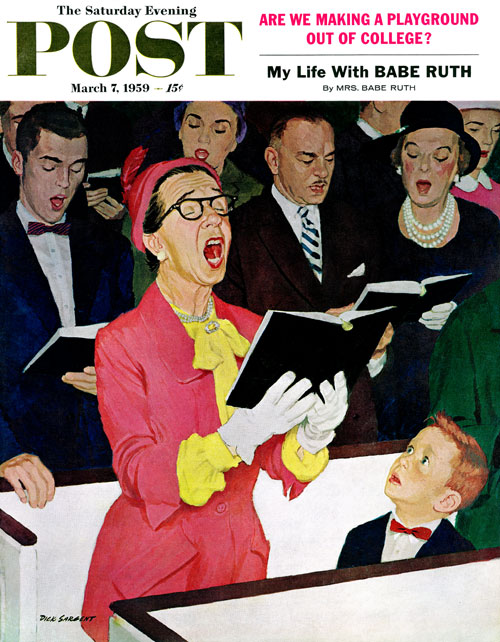
Singing Praise
Dick Sargent – March 7, 1959
“Never before has that little boy heard anything like Mrs. Bellows,” the editors said of this painting. Typical of artist Dick Sargent’s delightful humor, “Singing Praise” was a cover in March 1959. We don’t have to tell you the boy’s face is priceless (but we’ll say it anyway).
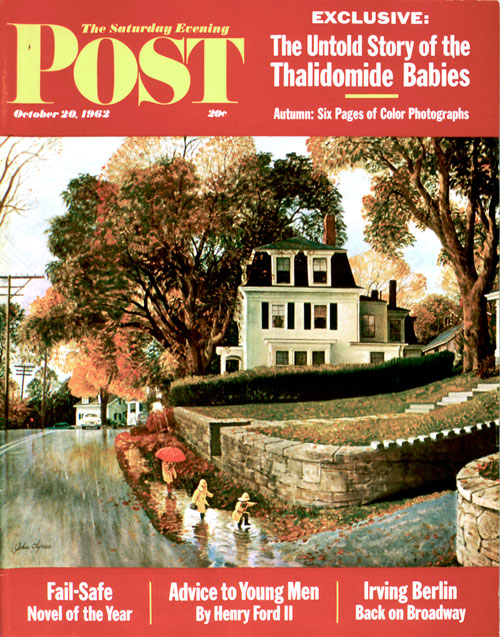
Walking Home in the Rain
John Clymer – October 20, 1962
The exhibit features several John Clymer covers, and this one from 1962 combines the artist’s talent for painting nature with a charming scene of children walking home in a chill autumn rain. The artist came across the scene in Rockport, Massachusetts while traveling and “looking for Americana”. “If there is a puddle to be found,” the artist noted, “kids will find it and walk in it.” Well, gee, isn’t that what boots are for?
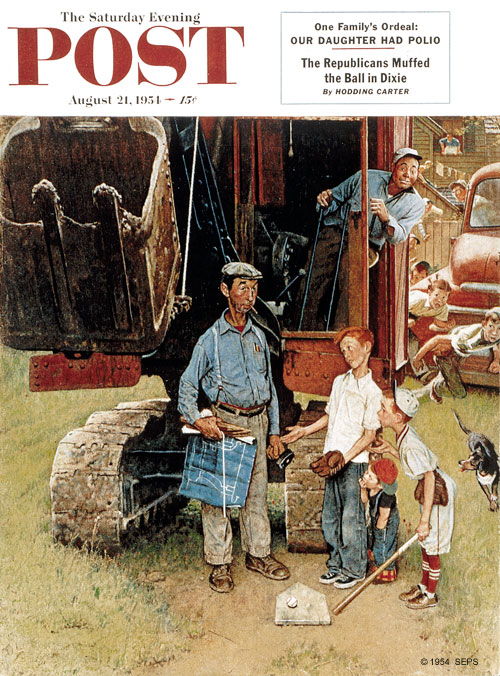
Construction Crew
Norman Rockwell – August 21, 1954
This is progress? Home plate is giving way to the bulldozer for a new house. Always one for authenticity, Norman Rockwell found the boys by knocking on doors in Stockbridge and asking for members of the Little League team. Some were used as models in later covers. Is the tiny boy sucking his fingers too cute or what?
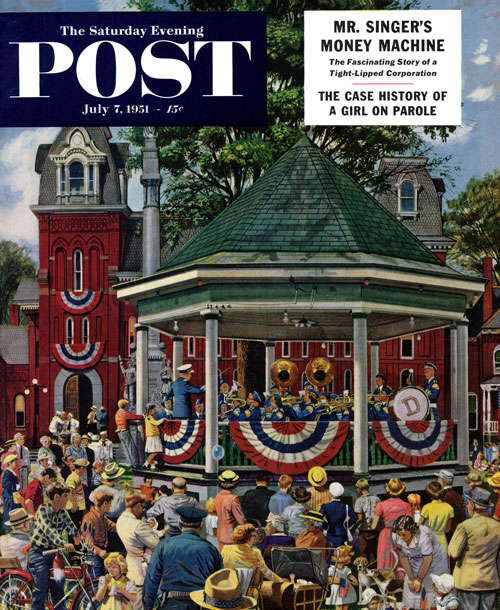
Patriotic Band Concert
Stevan Dohanos – July 7, 1951
Stevan Dohanos did over 120 memorable Post covers, and readers loved this one from 1951. There is a lot going on at this Fourth of July concert in Delhi, New York. Grandparents listening, dogs and kids checking things out, sailors chatting, and tiny tots are having meltdowns. The editors noted, “When Dohanos set up his easel opposite Town Hall, passers-by forgathered to see why, and the first thing they knew, the were on canvas.”
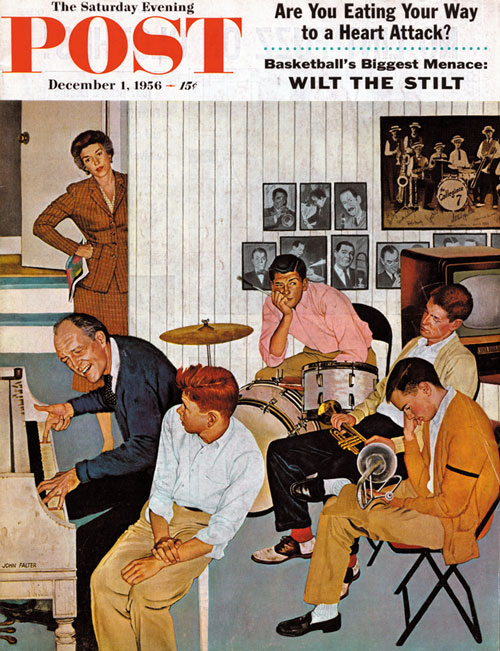
Jamming with Dad
John Falter – December 1, 1956
Dad crashes junior’s jam session and the guys are, well, less than enthused. Artist John Falter also did well over 100 Saturday Evening Post covers, and life with kids was a favorite topic. Note the college band photo on the wall – straw boaters and all. The photo montage of jazz greats gives us a clue to the type of music dad finds cool, and the kids…well, let’s just say they don’t dig all that jazz.
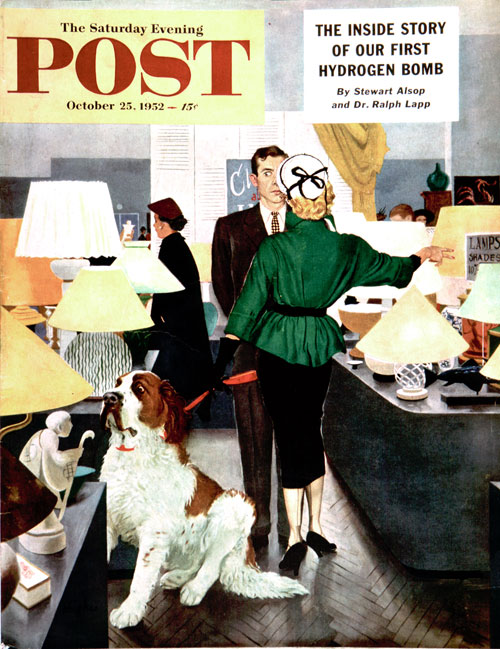
St. Bernard in Lamp Shop
George Hughes – October 25, 1952
Another frequent Post cover artist, George Hughes, clearly sympathizes with the nervous clerk in this painting from 1952. Editors noted, “it can be said in this lady’s favor that she would not take a bull into a china shop.” One swipe of Bernie’s tail would probably make the point moot.
Classic Covers: Sled Dogs or Dogs That Sled
It’s a classic Norman Rockwell cover from 1919. The boys are careening downhill on a sled, having a great ol’ time. But look at the dog’s face. Sheer terror!
Now, we could swear it was the same dog on a 1923 Country Gentleman cover by a prominent artist named J.F. Kernan. Did Rockwell lend Kernan the dog? If so, the mutt had taken to sledding in the intervening years. This one is going for the gusto!
Really, people should ask Fido if he wants to go for a sleigh ride. On a 1930 cover by artist Alan Foster, the boy and grandpa are having a great time, but the pooch is nearly as terrified as the Rockwell dog above. We wonder if grandpa made it all the way down the hill with his still lit pipe.
Sledding by sunset are the folks on the 1948 cover by artist John Falter. Reluctant to give up a great winter’s day, the kids are still at it. And yes, one little white pooch is still sledding (in a little girl’s arms).
The snowfall is so deep on artist John Clymer’s January 1954 cover that dad is up on the roof clearing it off. Junior, on the other hand, is enjoying the white bounty, taking the dog for a sled ride. This pace a dog can handle.
Our earliest sledding cover? This beauty from November 1900. The snow created a social event, with people trudging uphill greeting sledders going downhill. And, yep, there is a pooch in the center of the action, having a ball in the snow.
George Kernan
January 13, 1923
George Gibbs
November 24, 1900
Alan Foster
February 8, 1930
John Falter
December 18, 1948
John Clymer
January 23, 1954
Norman Rockwell
December 27, 1919
Classic Covers: Trick or Treat!
Saturday Evening Post covers through the decades have creeped us out with witches, goblins, and even a scary neighbor or two. They’re all in good fun, but you might want to keep the lights on as you observe the talents of some of our favorites.
A parade of trick-or-treaters is walking by on artist John Falter’s 1958 cover with even Mom wearing a scary mask. Or, as the Post editors put it at the time: “Mrs. Oldwitch and five little creeps are out on a shakedown cruise.” Editors are nice people. Really.
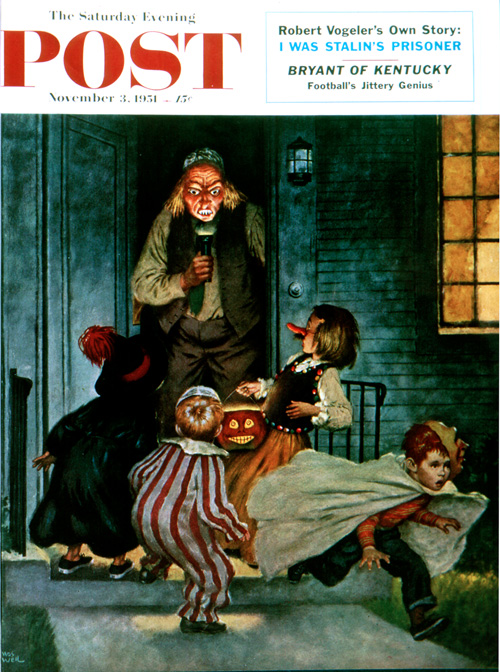
by Amos Sewell
November 3, 1951
There’s one of these guys in every neighborhood: Artist Amos Sewell shows a homeowner who decided to don a creepy mask to freak out the neighborhood kiddies. (Maybe he’s an editor.) The flashlight focused on the mask provides early special effects, and it works on the neighborhood goblins who flee in terror. We secretly hope the old guy gets his windows soaped. But on the other hand, being scary is what Halloween is all about.
Talk about scary! Artist Edgar Franklin Wittmack (Halloween 1926) shows us a dapper young man on his way to a Halloween party. But he’s terrified of a very large, very sinister shadow, and we don’t blame him! Just what is that creepy shadow, anyway? Perhaps it’s the deliciously creepy witch from famous cover artist J.C. Lyendecker’s October 1923 cover. But wait—there are more witches! It’s Witches Night Out on artist Eugene Iverd’s 1927 cover—they’re flying everywhere! Trick-or-treaters: beware!
by John Falter
November 01, 1958
by J.C. Leyendecker
October 27, 1923
by Edgar Franklin Wittmack
October 30, 1926
by Eugene Iverd
October 29, 1927
by Amos Sewell
November 3, 1951
